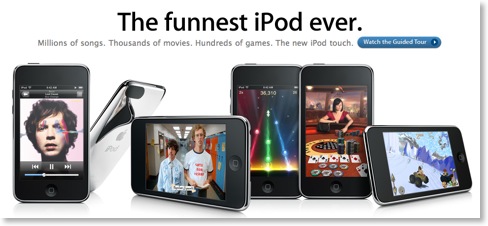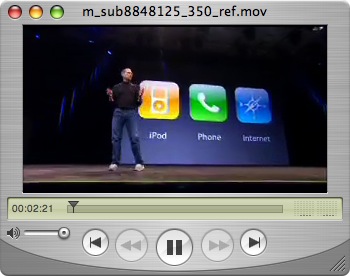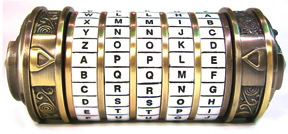The End of the Mac As We Know It (Reflections Upon Snow Leopard)
This post has been relocated to
http://thislamp.com/?p=1545
Please continue any discussion and redirect any known links to the above URL.
Thoughts on the New iPhone & What's Still Missing
http://thislamp.com/?p=1772
Please continue any discussion and redirect any known links to the above URL.
First Look: Hebrew & Greek Biblical Texts on the iPhone
The screen shots below are from a beta released yesterday from Olive Tree (I have permission to post these images):
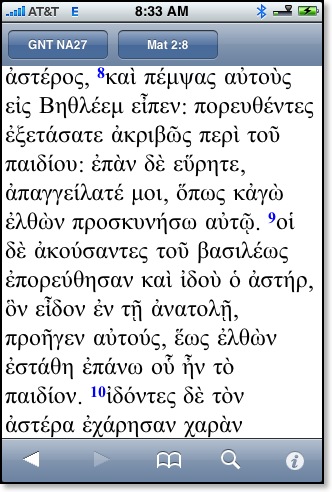

Frequent readers of This Lamp will know that I’ve lamented the loss of original language biblical texts “in my pocket” ever since switching from my Palm Treo to the iPhone last year. After a long wait, Olive Tree comes through with the promise a full replacement, and I have to admit that the texts look much better here than they ever did on my former device.
As you would expect, these texts are fully downloaded to the iPhone and do not require an internet connection for repeated access.
While I’ve got your attention, let me show you a couple of other things Olive Tree is working on for their Bible Reader.
Since my initial review, Olive Tree has incorporated links to textual notes and cross references in their modules.
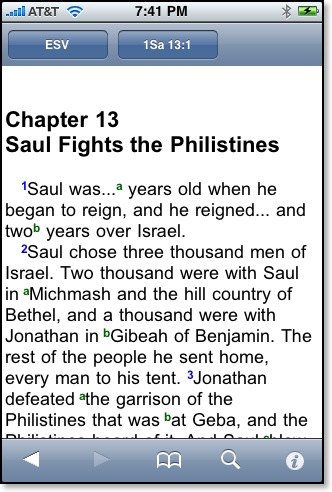

For instance, as demonstrated in the above modules, clicking/touching the superscript letters in the ESV leads to a appropriate section in the ESV notes. This is still not split screen, which I would prefer, but it’s a good start.
Traditionally, Olive Tree has allowed users who purchased texts for one platform to download these on any other platform as well. For instance, after purchasing modules for the Palm years ago, I was also able to download the same texts to a Windows Mobile device while I was testing one out a while back. However, this generous level of cross platform mobility has not been possible so far with the iPhone because Apple tightly controls iPhone apps and requires them to be distributed via the iTunes Store only with the exception of beta releases as seen in some of the images here). And not only do previously purchased modules have to be re-purchased, they have to be purchased separately. Again, this is not a policy from Olive Tree, but rather from Apple.
Right now, for instance, if an iPhone user purchases the NIV Family Pack for Bible Reader and the ESV Study Bundle, two separate installations of the Bible Reader are loaded with each respective set of modules. Other text reader programs in the iTunes App Store have been allowed to include modular purchases, so Olive Tree is trying to work with Apple to make the same kind of access available to users of their Bible Reader.
These screen shots below from a beta release (features not yet approved by Apple) show a “store” from Olive Tree where users could purchase texts directly for download over the internet to their iPhones. Once texts have been purchased and downloaded, they show up on a “My Olive Tree Account” page.
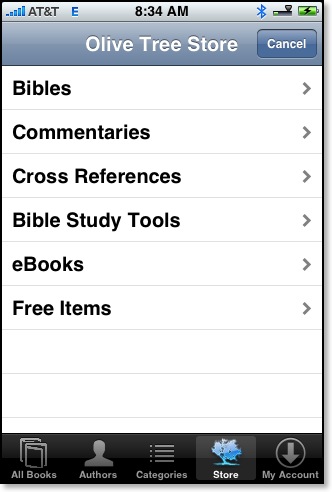


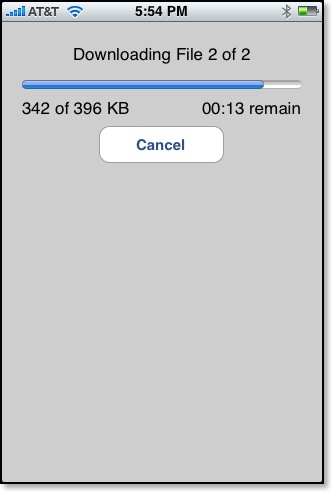

Let’s hope that Apple will approve Olive Tree’s solution because it’s a good and fair answer to the current modular dilemma.
See also:
• Olive Tree’s iPhone page
• To see Olive Tree’s current offerings in iTunes, search for “Olive Tree” in the iTunes Store Search window.
Then in the “Applications” box, select “See All.”
What Is It with Apple and Grammar?
When I was in high school, none of my teachers would have allowed me to use the sentence above from Apple’s newest iPod touch campaign.
Technically, there are at least two problems with the ad. First, the period implies that the text is more than a label or description, but rather an actual sentence. Yet, if I were grading a paper and saw this exact text, I would label it an “incomplete sentence.” Of course advertisers regularly add periods to text such as this to give a description a sense of finality. Essentially this is shorthand for saying “[This iPod is] the funnest iPod ever.”
Second, there’s a problem with the word funnest, which technically isn’t a word at all. According to traditional English language rules, funner and funnest are not words. If a writer wants to use a comparative or superlative form of fun, correct usage dictates the selection of more fun and most fun, respectively.
Of course, using either of the correct forms makes for awkward advertising copy:
The most fun iPod ever.
or more correct:
This iPod is the most fun iPod ever.
or perhaps Apple could have just said
My new iPod is a lot more fun than your old iPod.
Okay, I can see where correct grammar doesn’t always make for good advertising. And I also have to assume that Apple’s advertisers aren’t uneducated, and they fully realize they are breaking the rules of good usage. Since Apple Macintosh computers come with a software dictionary based upon The New Oxford American Dictionary, I had to wonder what Apple’s own software would say about using the word funnest.

Well, according to Apple’s own internal dictionary, the usage for the word fun may indeed be changing. Note the last sentence: “The adjectival forms funner and funnest have not ‘arrived’ in all the dictionaries, however, and if employed at all, they should be used sparingly and not in formal written English.” Okay, fair enough. Advertising copy is not necessarily a formal context--at least not in regard to this advertisement.
When I teach writing classes, I strongly enforce the rules of grammar and usage because I feel that the parameters given in students’ textbooks offer a foundation for writing that can be modified later in appropriate contexts. I tell my students that great writers know when to bend the rules of grammar accordingly. For instance, Shakespeare regularly invented words when the glossary of his day didn’t express his intention (such as the adjective form of “alone,” lonely). Tolkien will occasionally use a double negative in The Lord of the Rings, but he does so with purpose in order to create a positive meaning from the combined words. A sentence like “It was a dark and stormy night” is not only cliched, but also begins with a pronoun lacking an antecedent. Nevertheless, Madeleine L'Engle could begin A Wrinkle in Time with those very words because she knew what she was doing and was an established writer by the time she wrote that book.
Even Apple’s detractors usually admit that the company makes great products--often products that set the parameters of the playing field for their competitors. So, perhaps they can get away with phrasings that would quickly be marked off on one of my students’ papers. And this is not the first time Apple has been known to break grammatical rules. English teachers gritted their teeth over the “Think Different” campaign in the late nineties (think is a verb and would require the adverb differently, not the adjective different).
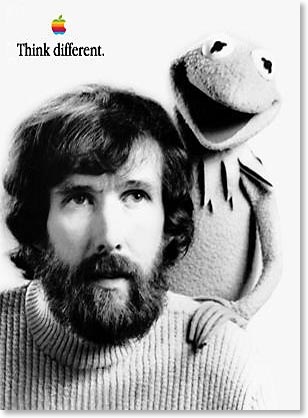
Nevertheless, if you are one of my students reading this, stay away from funnest or I’ll mark it accordingly!
Olive Tree Comes to the iPhone: Finally the Promise of a Decent Bible App
Well, wait... there was still my iPod, obtained in 2002. Although I didn’t carry it with me everywhere as I had done with the cell phone and PDA, it was still handy for listening to audio books, the Mars Hill Audio Journal, and occasionally some music. But it was always something else to keep up with.
Then in 2007, my electronic gadget world converged one more time with the iPhone. Now I had a PDA, cell phone and iPod all in one device. But two things were missing on the iPhone that I had used quite extensively on previous Palm PDAs, including my Treo: Pocket Quicken and Bible software from Olive Tree.
Intuit now has an online version of Quicken that works with the iPhone, but I’m not yet sold on the idea of placing all my financial data into “the cloud.” Originally Apple was not going to open the iPhone to 3rd party applications, insisting that all such endeavors were to be handled through Web 2.0 internet apps. Regarding Bible applications, there were initially some halfway decent web apps, but they had two drawbacks: (1) they were all dependent upon internet connectivity to work, and (2) there was no real support for original language texts.
With the advent of iPhone 2.0 software last month, we were finally able to obtain true third party applications on our iPhones. But as I had previously written, I had been enormously underwhelmed by initial offerings because they were either lackluster or required internet connectivity to function.
Yesterday, Olive Tree launched its first offerings for the iPhone: its BibleReader and ESV Study Bundle for Bible Reader.
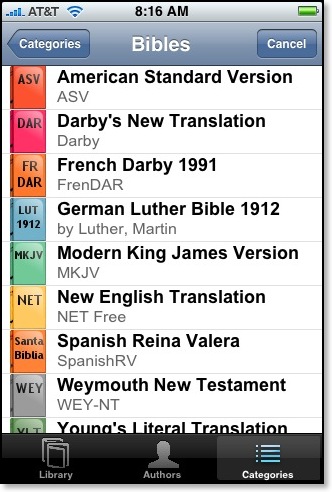
- American Standard Version
- Darby’s New Translation
- French Darby 1991
- German Luther Bible 1912
- Modern King James Version
- New English Translation (without notes)
- Spanish Reina Valera
- Weymouth New Testament
- Young’s Literal Translation
None of the texts in the free edition are formatted yet (image below on left), but as this screenshot taken iTunes (image below on right) shows, the ESV text is formatted:

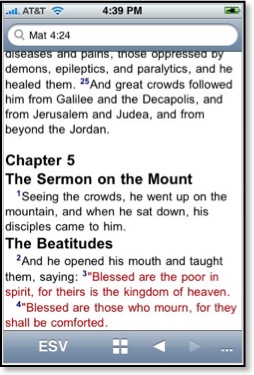
I’m not sure yet if the red lettering can be turned off. The ability to turn off red lettering will come in a later update.
The search dialogue at the top of the screen can be used for either direct reference input or word searches. It also automatically updates as the user scrolls through the biblical text. A search for “righteousness” yields 134 hits in the NET Bible as seen below:
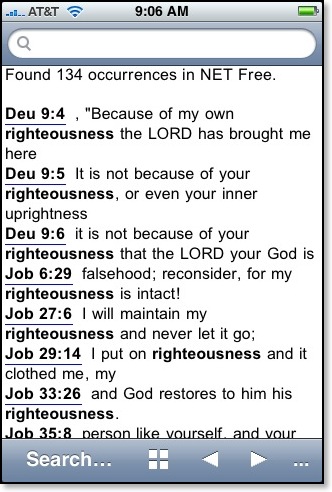
Touching any of the underlined references takes the user to the verse in context of the entire passage. Pressing the icon at the bottom of the screen (is that a window or a plus sign?) brings up a listing of all books available in that particular Bible module:
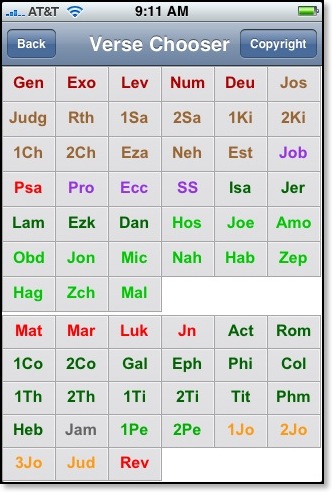
Clicking on any of the biblical books leads to another screen (not pictured) that lists all chapters in the biblical book and then to another screen with all verses. Selecting a particular verse will not display the verse by itself but the entire passage in context which is very helpful.
The most beneficial aspect of Olive Tree’s BibleReader is easily that it does not rely on an internet connection to use any of the biblical modules. All texts are fully loaded onto the iPhone. I especially appreciate that because I still find myself without any signal from AT&T at times when I am deep into the heart of a building--especially older buildings. At this point, I’m not worried about space limitations. iPhones now come in either 8 or 16 GB models, so for most users there should be room to spare. This is in contrast to my old Treo 600, of course, with which I had to use an extra SIM card in order to store all 60,000 notes of the NET Bible.
The interface for Olive Tree’s BibleReader is completely customizable as seen in this settings screenshot:

In fact, until I installed BibleReader, I had no idea what fonts were available on my iPhone:
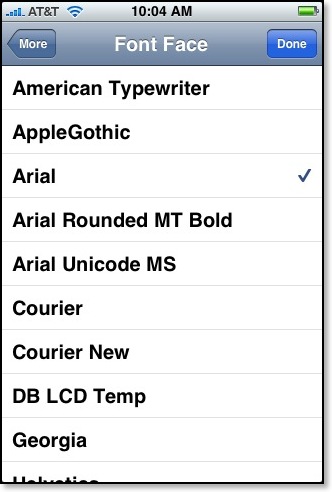
[In addition to the fonts listed in the graphic above, BibleReader also tells me I have the following typefaces installed on my iPhone: Helvetica, Helvetica Neue, Hiragino Kaku Gothic ProN W3, Hiragino Kaku Gothic ProN W6, Marker Felt,
STHeiti J, STHeiti K, STHeiti SC, STHeiti TC, Times New Roman, Trebuchet MS, and Verdana.]
I noted in the title of this blog entry that Olive Tree’s BibleReader was the first third-party iPhone Bible app with real promise. I say that because not all of their extensive language offerings are available yet, including their Greek and Hebrew texts. But I corresponded with Stephen Johnson of Olive Tree yesterday, and he assures me they are in the works along with many of the other modules in Olive Tree’s library.
Certain features that we’ve come to expect from Olive Tree, such as split screens, aren’t available yet, but features will be added to BibleReader over the next few months.
Users such as myself who had already purchased Olive Tree texts may face a bit of a conundrum. In the past if a customer had bought a module for the Palm platform and then switched to the WindowsMobile platform (or vice-versa), it wasn’t necessary to re-purchase the texts. For instance, a few years back I briefly owned a Compaq iPaq and was able to load modules such as the Greek New Testament with Gramcord morphology onto the Compaq device even though I had previously purchased it for the Palm platform. After a few weeks, I decided connecting to a WindowsMobile (I believe it was called WindowsCE back then) device from a Mac was too much hassle and switched back to a Palm PDA. In all of this switching back and forth, I never had to pay anything extra to OliveTree. I’ve always found their cross-platofrm policy to be very generous.
However, with the iPhone, the issue is a bit more complex and the problem doesn’t lie with Olive Tree, but with the iTunes Store. Apple doesn’t allow third-party iPhone developers to sell their applications from their own websites. It has to be done from the iTunes Store. So, for instance, if a user has already purchased the ESV text for a Palm or WindowsMobile device from Olive Tree, there’s no way at present to keep from paying for it again if purchased for the iPhone. Olive Tree is in talks with Apple to determine if there’s a way around this, but for right now if an ESV aficionado already bought it for another platform and now wants to install it on the iPhone, he or she will have to pony up another $24.99.
And there is another problem for Olive Tree and their customers. Olive Tree’s modular model of distributing texts doesn’t work as well with the iTunes Store. In the past on the Palm or WindowsMobile platforms, once the BibleReader software was installed as many text modules could be added as their was room available in the device’s memory. Currently, the iTunes Store doesn’t allow this adding of one text at a time as the previous model allowed--at least not without having many separate apps installed on the iPhone. So, if for instance, Olive Tree releases the TNIV text next week, a user couldn’t simply add it to an already-purchased ESV Study Bundle. Rather, two separate installations of BibleReader would have to be installed with the TNIV in one and the ESV and accompanying resources in the other. And theoretically, even once split screen features are implemented, modules in two separate installations couldn’t be viewed side by side.
This complication is not something that just affects Olive Tree, but rather all developers who offer modular add ons to its software. Again, Olive Tree is in talks with Apple, and hopefully the way iTunes is currently set up can be adjusted for the benefit of the customer in the future.
Regardless of these early snags, Olive Tree’s venture into the iPhone platform looks very promising. I am hopeful I can eventually reproduce the same functionality with Bible texts on my iPhone that I had previously experienced on my Treo. Since useful iPhone Bible functionality is something I am genuinely seeking, expect to see more on This Lamp about the subject as new developments arise.
For further information:
Olive Tree’s iPhone Page
Olive Tree’s Blog
This Lamp Will Be Down on Wednesday
I’m not too thrilled about .Me instead of .Mac by the way. Apple says that both will still work, so I’m not changing my email or web address just yet, but I have to wonder if two or three years down the road they might announce that all mac.com addresses will be no more.
I’ve thought about moving This Lamp to its own dedicated server space with a real thislamp.com address (right now, it only forwards to what you see in your URL line above), but that would also entail a lot of resetting internal links, so right now, I’m undecided.
Regardless, if you drop by on Wednesday and don’t find This Lamp, don’t panic, it should be back within a few hours.
Leopard Guided Tour
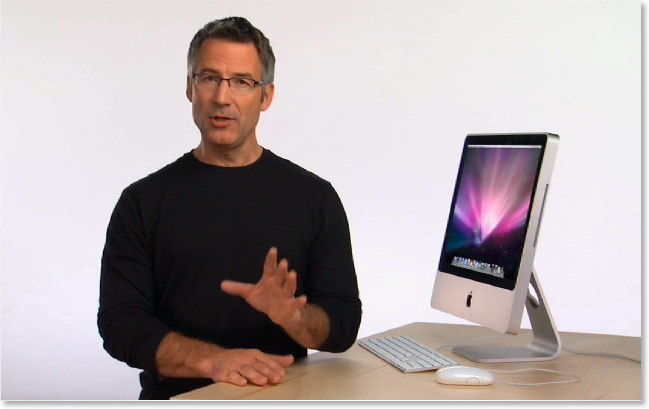
And if that's not enough, check out Apple's page of 316 new features in Leopard.
3rd Party Apps for the iPhone: Finally
Let me just say it: We want native third party applications on the iPhone, and we plan to have an SDK in developers’ hands in February. We are excited about creating a vibrant third party developer community around the iPhone and enabling hundreds of new applications for our users. With our revolutionary multi-touch interface, powerful hardware and advanced software architecture, we believe we have created the best mobile platform ever for developers.
It will take until February to release an SDK because we’re trying to do two diametrically opposed things at once—provide an advanced and open platform to developers while at the same time protect iPhone users from viruses, malware, privacy attacks, etc.
I want just two things: Pocket Quicken and a robust Bible app with access to the original languages. The screen on the iPhone has a much higher resolution than any Palm or Windows Mobile device, so Greek & Hebrew should look incredible...assuming they get Hebrew working on the iPhone, that is...
The downside is that if an SDK is not available until February, it might be a number of months until significant apps are released.
10 Days to Leopard
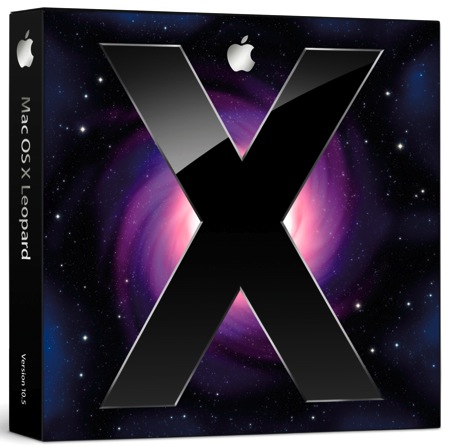
Apple's website has now been updated allowing us to see even more details about the new OS, including what they are counting as 316 new features. Not all of these features are earth-shattering, and some have appeared in various forms on the Linux or Windows platforms, but the release is significant nonetheless.
Final requirements for the new OS are as follows:
- Mac computer with an Intel, PowerPC G5, or PowerPC G4 (867MHz or faster) processor
- 512MB of memory
- DVD drive for installation
- 9GB of available disk space
- Some features require a compatible Internet service provider; fees may apply.
- Some features require Apple's .Mac service; fees apply.
In case you Mac users didn't catch it, G3 processors have been completely cut from the list of computers that will run the lastest OS X, as well as certain G4's such as my Cube which I'm about to put on Craig's List anyway.
I've already been asked if I'm going to stand in line for my copy of Leopard. Well, I'm not, although that would certainly be a fun thing to do. However, ever since the eighties when I began buying software, I've usually been able to receive academic discounts. If I wasn't a student, I was a teacher. If I wasn't either, Kathy was one or the other, so I've always had such access. However, I was disappointed that the academic price of Leopard is only $116, a mere 10% off the regular price of $129. In the past new releases have been $79. I know that folks who pay full price regularly will have no sympathy, but I find it ironic that during Apple's most successful time in the history of the company, they've become the most stingy in their pricing.
The image below shows off the new desktop in Leopard. Notice the new "stacks" feature meant to keep your desktop uncluttered. what I find interesting is that there are no icons on the desktop at all, not even an icon for the main hard drive.

If this is the new default desktop, personally I hope that it can be customized. I'd prefer to have an icon for the hard drive and any other files or application aliases I choose to park there. If memory serves, the original OS X public beta in 2000 did not have a desktop hard drive icon either, but demand from users made Apple change this by the final release in the Spring of 2001. I think Unca Steve just likes clean desktops and wants all of us to appreciate the same. In general, I clean mine up every two weeks or so and either file or delete stray icons. Nevertheless, I'd prefer to have the option for a messy desktop if I want it. A desktop in which a person cannot add any icons at all reminds me of Windows 3.x in which the user could only change the desktop picture.
I'm very intrigued by some of the new features that work with the .Mac service. One of the most valuable aspects of .Mac for my needs is the ability to sync calendars, address books, email, web bookmarks, keychains, and more on any Mac in which I have a login. Even if I am going to use someone else's Mac for a temporary amount of time, I can create my own login, add my .Mac info and within minutes, all my personal information is included on the new machine. Leopard adds further functionality such as syncing dock items, dashboard widgets, notes, and system preferences.
I'm also intrigued by the new "Back to My Mac" feature described as "Connect to any of your Mac computers at home from any Mac on the Internet. Your home computers appear in the shared section of the sidebar. Just click and you’re in." That's really helpful since the 160 GB hard drive on my MacBook gets pretty crowded. Now, I'll be able to leave files on my desktop machine at home and access them from any place I have internet access.
In case you haven't guessed by now, I tend to be an early adopter with these kinds of things. Yes, I know there's always room for disaster, but I backed up all my personal files just this week, and I never add hacks to my system that often are the cause of problem upgrades. Apple's promised to deliver Leopard on the afternoon of the 26th. My MacBook will updated within the hour. If you don't hear from me for a few days afterwards, you can just assume that everything blew up.
The Apple Key Is Dead (13 years late); Long Live the (solo) Command Key

Apple has a history of changing its basic tools of user interface--namely the keyboard and mouse--and letting the fallout of controversy land where it may. The totally redesigned ultra thin keyboard that accompanies the new aluminum iMacs is no exception. Mac users either love it or hate it. I've spent a little bit of time with one, and I'm a bit undecided. However, I'm also a big fan of the Matias Tactile Pro keyboard, and if you know what that is, you know it's very different from Apple's new keyboard.
And yet in the changes that have come with the new aluminum keyboard, one alteration that I've seen get a little attention, but not much, is the removal of the Apple logo from the Command key:
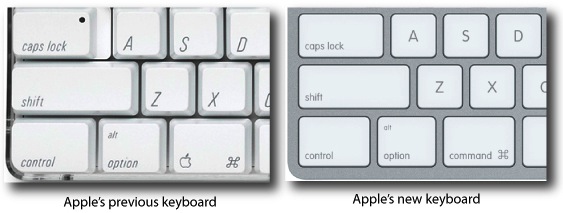
Note that the Apple logo has been completely removed from the Command key and now this key is labeled like the the control and option keys are. Incidentally, over the years, I've heard the Command key called the "Apple key" (Kathy tends to do this), but I've tried to avoid it myself since all manuals and instructive literature from Apple have used Command. However, when trying to help folks who have switched to the Mac from Windows, I would get blank stares when I said, "Hit the Command key," and inevitably, I'd resort to "or the Apple key."
But here's the question of point to this post: how come the Macintosh keyboard had both the Apple symbol and the Command symbol to begin with?
Technically, the question itself is a misstatement since the original 1984 Mac 128K keyboard did not have the Apple symbol on the Command key, although the Command key and Option keys were indeed there. The keyboard layout is essentially the same today except that the original Mac didn't have a Control key.
Over the years, I've heard various explanations about the origins of that "butterfly" looking Command symbol (it's not really a butterfly), but I'd never heard why the Command key had an Apple on it, too (up until the new aluminum keyboard, that is). And then I stumbled across the answer yesterday. I was reading a January, 1989 (yes, you read the year right) issue of the now defunct magazine (at least in the U.S.) MacUser. In the section called "The Help Folder," Chris Espinosa was asked this very question.
As an aside, Espinosa has been an employee of Apple since the days that it was in Jobs' parents' garage, and he still works there today. Further, he was part of the original Macintosh team, so even in 1989, he was the perfect one to answer this question. This is all nothing more than Apple Trivia, of course; but nevertheless it's interesting. I'll reproduce the question and Espinosa's answer from the original January, 1989, MacUser magazine below. The bracketed note in the question is mine, but the bracketed note in the answer belong to the 1989 MacUser editor.
Q. What does the funny symbol on the Command key mean? And why is there an Apple symbol next to it on the new keyboards [Rick's note: keep in mind the reader is asking about the keyboards that were new in 1989!].
A. On the Apple III way back in 1980, we put two Apple keys on the keyboard for programs to use as they wished. We put an Apple key on the Apple IIe's keyboard when we introduced it in 1983. In 1983 the Command key on the Lisa keyboard also had the Apple symbol on it.
The Macintosh was going to use the same symbol and have the Apple symbol in the menu for the Command-key equivalent, just like the Lisa. But late in 1983, somebody (I bet you can guess who) decided that using the Apple symbol on the keys and in menus was "corrupting the logo"--sort of like those rare Britons who don't lick postage stamps because they don't approve of spitting on the back of the Queen's head. So we had to change the keyboard and the software and the documentation all in a very short period.
But first we had to come up with a good Command key symbol. The requirements were pretty heavy: It had to be small, recognizable, unique, and easily rendered in a simple font character (for the menu), an it had to mean "command." The International Standards Organization (ISO) book of symbols offered little help (its recommendations for the Shift and Option keys can be see on Apple's non-American keyboards).
Finally Susan Kare and Barbara Koalkin found the symbol that's now affectionately known by many names: flower, propeller, freeway, splat, command, feature, and cloverleaf [Don't forget butterfly.--Ed]. It came from a book of Swedish campground trail markers and means "remarkable feature!"
The Apple symbol came back with the introduction of the ADB (Apple Desktop Bus). Now that Apple keyboards are interchangeable among many Apple computers, that key has to do double duty: It's the Command key on the Macintosh family and the Apple key on the Apple IIGS.
So there you have it. They key served two different platforms, and it was legitimately the Apple key or the Command key based on what computer one was using--back when people were using Apple II's that is. However, I find it interesting that Apple discontinued the Apple II platform in 1994 (when it was already way past its prime), but didn't get around to removing the Apple symbol until 2007. That's 13 years late! And isn't it odd that the Apple symbol was retained even on the USB keyboards in spite of the fact that Apple II's were discontinued well before the creation and adoption of the USB standard. I suppose the Apple symbol was retained because that was what people were used to, even if hardly anyone knew why it was there anymore. Can anyone say, "Meaningless tradition"?
Regardless, now it's gone, and better late than never, I suppose. So...
The Apple key is dead!
Long live the Command key!
Apple Store: Oxmoor/Grand Opening Pictures, Reflections
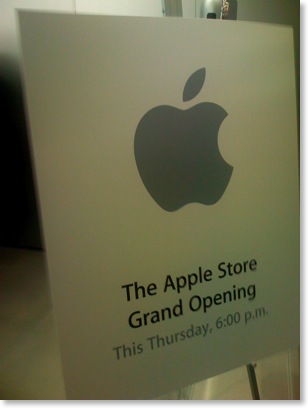
Okay, I admit it. I'm the kind of person who will stand in line for stuff like this. I've seen quite a few midnight showings of movies on their release day. In 2004 I stood in line to get a copy of Halo 2 for the Xbox at midnight. A couple of months ago, I stood in line to to get an iPhone on its launch date. What's wrong with me (and others who do the same thing)? Am I simply too impatient? Did I have to be at the Oxmoor Mall for the grand opening of Louisville's new Apple Store? I mean couldn't I go this weekend and avoid all crowds?
Certainly. But that's not why we go.
Such activities are an event themselves, a pinpoint in one's personal history that merges with the history of significant cultural events. Standing in line with folks you don't know personally, but with whom you obviously have much in common makes for great conversation despite a lack of personal history. You can look back and say, "I was there--there on the very first day."


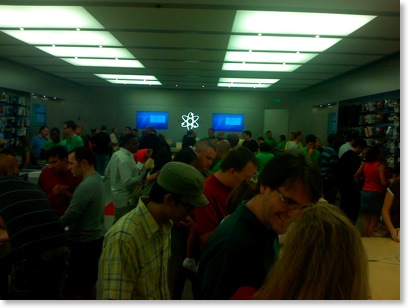
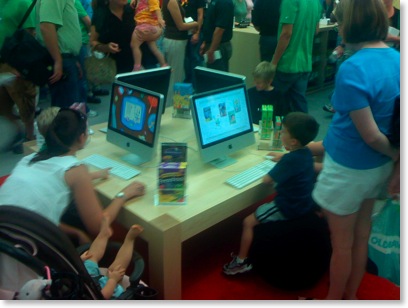
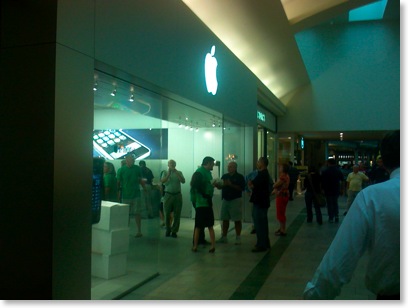
All of the sales people were extremely friendly. I didn't leave to cheers (because I didn't purchase anything), but I did get my t-shirt and friendly farewells from the Apple Store employees. One of the workers, a young man in his twenties with bright red hair said to me, "Isn't this great?!" He seemed just as enthusiastic about being an employee as the rest of us felt about being customers. I said, "Yeah. Hey, are there any grand opening specials going on tonight?" I hadn't seen any indication of such, but often stores such as Best Buy will offer tremendous sale price savings for the entire week when a new store is opens. He smiled, and without hesitation said, "No, really the free t-shirt is the special tonight." Makes sense. There was a steady stream of people to get in, and another steady stream of people walking out with iPods, iPhones, and iMacs. Why on earth would they need to run specials. Cult of Mac, indeed.
But at least I got my t-shirt.
Don't forget to see all my pictures of the Apple Store Oxmoor Grand Opening at my web gallery.
New Version of Apple Pages Checks for Gender-Specific Words
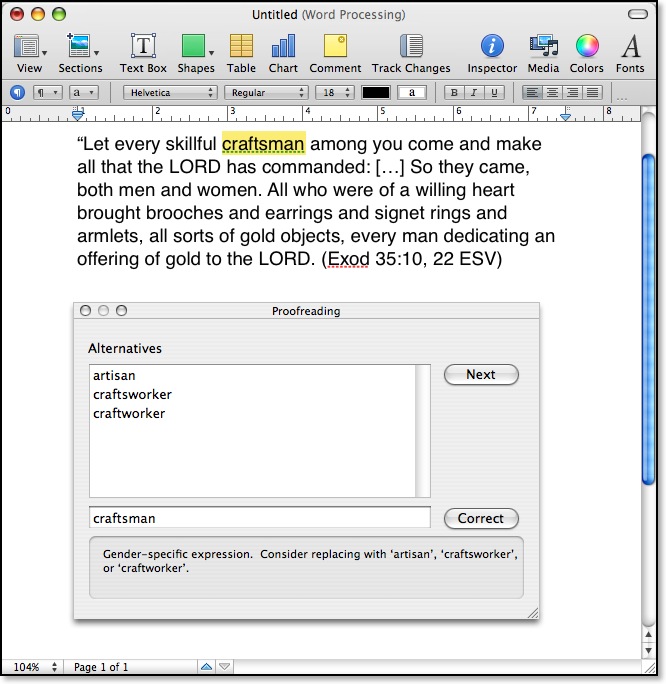
I didn't know it until today, but MS Word 2004 checks for gender-specific terms, too. However when I pasted the above verse in Word, kinsman was not flagged.
Pages, which is part of Apple's iWork suite was introduced in 2005. Version 3 (or '08), which debuted yesterday, is the first release to include a grammar checker of any kind, and evidently, it's more specific than that in the current version of Word for the Mac.
This Lamp Set to Move (Tentatively)

I also think I've begun to reach the limits of RapidWeaver's ability to handle my site. The recent update improved this somewhat, but there are still problems. The actual site on the web is over 1300 separate files, but RapidWeaver keeps them all contained in one file on my MacBook. Right now, this file is over 150 mb in size. It takes a while to load and forever to save and shut down. I have continued fear of it losing integrity one day, but I do back it up regularly.

If you simply have my site linked/saved/bookmarked as www.thislamp.com, you will be fine as I will simply change the pointers to the new site. However, if you link directly to these files or subscribe to the RSS feed, you will have to update your bookmarks.
There's still a chance this won't happen, but from everything I've seen of iWeb '08, I think it's about time to pack my virtual bags.
iPhone Bible App Roundup: July 2007
Let me say up front that on the iPhone, there's nothing like the kind of offerings Olive Tree has for other PDA's and smartphones. In fact, I contacted Olive Tree to see if they were working on any kind of solution for the iPhone. They asked me if I would be interested in testing the text files they offer for iPods on my iPhone since no one at Olive Tree actually has an iPhone. I had to inform them that text files cannot be placed on an iPhone in the same manner that one can on an iPod because the free space on the iPhone's flash drive cannot be directly accessed. At this point, I don't know where Olive Tree's strategy stands for the iPhone, if there is one at all.
A major drawback of the iPhone is that Apple will not allow third party applications on the iPhone at this point. Now, I've heard rumors that a software development kit is in the works, but supposedly the Windows version isn't up to speed with the OS X version at the moment, so Apple wants to wait until the SDK's have platform parity before either is released. These days, Apple Inc. (no longer Apple Computer) has quite a few Windows software offerings and actually sells more iPods and iPhones to Windows users than to Mac users. Until the Windows SDK is up to par, we have no third party apps. Again...if this rumor is true at all.
The solution, and one endorsed publicly by Apple, revolves around Web 2.0 apps that can run in the iPhone's stripped down Safari browser. Quite a few "programs" have been released so far and are cataloged at websites such as The iPhone Application List. Some of these applications are quite handy, but in the interest of myself and readers of this blog, I thought I would try to create an ongoing series regarding the Bible offerings for the iPhone as they become available.
Currently, there are three iPhone applications that offer access to the Bible. I will offer brief reviews of them in the order they were released.
iPhone Scriptures/LDS Standard Works (KJV & Mormon)
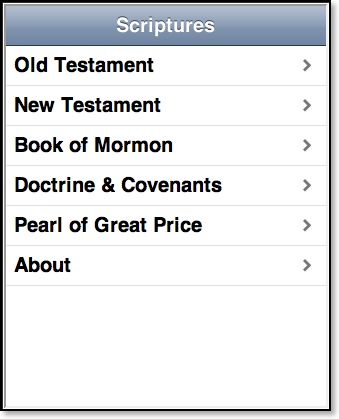
Technically, these are two separate programs, but they use a similar interface, so I'm going to assume there's some connection between them. Released about a week after the launch, iPhone Scriptures was the first Bible related app available for the iPhone. The interface is straightforward. Clicking on a selection such as "New Testament" offers the user a list of New Testament books. Selecting a book takes the reader to another screen with chapter numbers. Selecting a chapter yields the entire text for that chapter:

The button at the top of the text that says "Library" takes the reader back to the initial screen. What seems to be an obvious omission are arrows that would take the reader to the previous or next chapters. No search features are present, but it's promised to be available soon. In case you didn't notice, the biblical text is limited to the King James Version, which is the officially used translation of the Mormon Church. This isn't surprising, but will certainly limit widespread use of this program.
The only functional difference between iPhone Scriptures and LDS Standard Works is the ability to turn off the Mormon Scriptures in the latter program for those who don't want to look at the Mormon-specific titles. This is done in a "Settings" tab at the bottom in place of the "About" tab in iPhone Scriptures.
I saw iPhone Scriptures within a day or two of it's release, and the initial interface had very tiny tabs making it virtually unusable. The current version is much improved.
3onesix Ministry Tools (NIV)
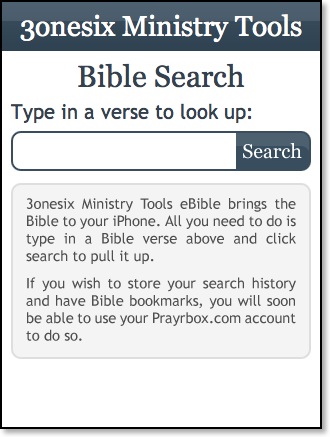
This Bible was released around July 10, and takes a slightly different approach to accessing the Scriptures than the programs mentioned above. In 3onesix Ministry Tools, the user must know what passage he or she wants to view in advance. For instance, typing "Matthew 1" results in that chapter being displayed.
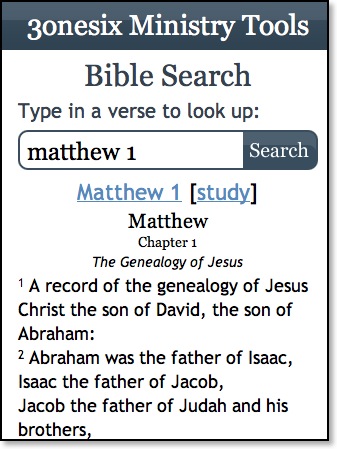
Clicking either of the links on the chapter screen takes the user to the regular eBible website which is what this program is based on. Currently, the only text available from 3onesix is the NIV, but one would hope that others would eventually be made available since eBible offers multiple versions. At the moment, unless the user goes to the eBible site, there is no direct search feature in the app specifically made for the iPhone.
iBibleSpace (ESV)
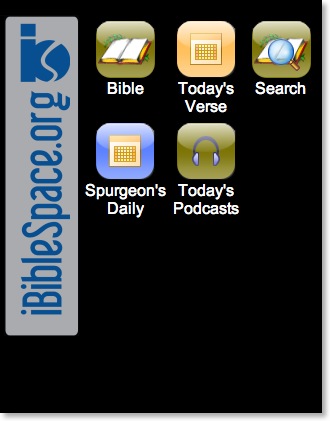
By far the most impressive iPhone Bible app to date is iBibleSpace released a couple of days ago. Anyone who has already spent time on an iPhone will immediately recognize an interface that draws its cues from the regular iPhone home screen. By choosing the first option, "Bible," one is presented with a similar interface as found in the original iPhone Scriptures application mentioned above, but it's designed to look much better in iBibleSpace. Again, the user can select a book of the BIble (OT & NT books are on the same screen), and then a chapter.

The text as shown above is quite clear, and contrary to the screenshots I took above on my MacBook (I don't know of any way to grab screens on my iPhone), the text such as the word "Reference" above fits perfectly onto it's button on the iPhone.
iBibleSpace has quite a few features going for it that puts it ahead of the other two iPhone Bibles. First of all, the ESV text as shown here includes access to textual footnotes: notice the "" at the end of v. 3. That note designation is actually hyperlinked and will take the user to the bottom of the screen where the footnotes all appear at the end of any chapter. You might also notice the right-pointing arrow that will take the user to--you guessed it--chapter 2 where there are both previous chapter and next chapter buttons.
A number of other options are offered at the top of the screen as well. The large single-colored left pointing arrow will take the user back to a listing of all chapters in the biblical book. The "Notes" button allows the reader to access a personalized account where one can store customized notes. The plus (+) button on the far right allows the user to add a new note and even highlight a verse in one of six different colors [gee, maybe I could transfer all the notes from my wide margin NASB to my iPhone!...or maybe not]. The "Reference" button takes the user to notes from Matthew Henry's Concise Commentary (not of great interest to me, but it's a nifty feature, nonetheless).
The only real downside I saw of the biblical text in iBibleSpace was the dreaded words of Christ in red. If this "feature" could be turned off, I believe that would be helpful to many.
Going back to the IBibleSpace main screen is simple because it always remains as a separate page/tab in the iPhone browser (in case you didn't know, the iPhone will allow the user to have multiple pages open at once, much like tabs in regular browsers). "Today's Verse" is just what you would expect it to be: a daily Bible verse. There is a link to read the entire chapter from which the verse comes in context if one is so inclined.
Another distinguishing feature of iBibleSpace is its search feature:
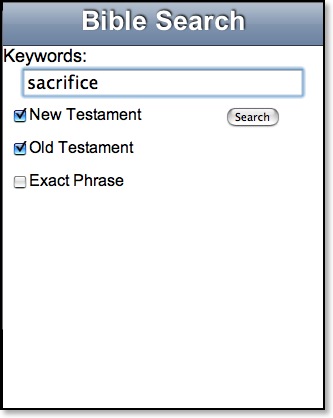
One can search either or both testaments and exact phrases. Results are displayed in groups of five at a time with an option to select "More."
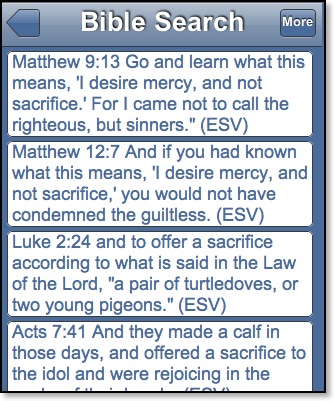
However, I found it odd that NT hits are listed before OT results. I would prefer them my results to be listed in canonical order. Further, in most Bible programs the search word is usually highlighted in some way, but not so in iBibleSpace.
The other two buttons on the home screen will lead the user to daily devotions from Spurgeon or podcasts from a variety of conservative Christian radio shows. The selections are a bit odd in my opinion. I cringed when I saw Joyce Meyer, but I occasionally enjoy listening to Ravi Zacharias' show. The great majority of the offerings, however, I would not have any regular interest in. I also doubt I'd run to my iPhone for a daily devotional from Charles Spurgeon either. In fact, it seems odd to me that it's a primary button on the home screen.
Regarding the podcasts, though, I followed one all the way to the show to see if the iPhone would actually play it. The link was to an MP3 file that launched QuickTime on the iPhone. I think that was the first time that I realized that I even had QuickTime on my iPhone!
iBibleSpace is impressive on many levels: features, design, and consistency of its interface (one never follows a link that leads to a page not formatted to the iPhone unlike the 3onesix app). Even though the ESV is not one of my preferred translations, I put iBibleSpace at the top of my iPhone app bookmarks. At the present time, iBibleSpace is far and away the best Bible app available for the iPhone.
I'd still like to see original language texts on the iPhone, although I have no idea if the iPhone would even support Greek and Hebrew fonts. Of course one would presume that it is using Unicode fonts already. Something like the NET Bible would be interesting to have on the iPhone as well, and perhaps because the folks behind the NET have been so Internet savvy, we will see something in the near future. One also wonders if an iPhone interface to something like Bible Gateway couldn't be created to take advantage of multiple translations.
Further, I still am hopeful for third party apps. The major drawback of any of these apps relates to their dependence on the Internet. Even with a WiFi connection, they are not as fast as a native application would be.
In the meantime, three weeks have yielded three distinct Bible apps of varying creativity and features. As others will undoubtedly come available in the weeks ahead, I'll be sure to cover as many as possible here on This Lamp.
iPhone = Convergence
In 2003, I had three electronic devices (not counting my laptop) I used regularly and carried with me most places: a Palm Tungsten T, my Motorola Timeport cellphone, and a 20GB (second generation) iPod. Then in October of that year, I obtained the newly released Treo 600 which combined the cellphone and Palm functions. The number of devices I carried were down to two. I remember reflecting at the time that if only I could combine something like the Treo with the functionality of the iPod, I'd be set.
I realize, of course, that to some such gadgets seem unnecessary, but they've become extremely integrated into my life. Let me explain. A little more than a decade ago, I carried a physical daytimer. It was convenient enough for the calendar and address book, but for anything else I had to remember where I had written it. Then in 1997, I bought a Palm Professional which appealed to my proclivity to all things electronic and computerized. Truth be told, there's something I miss about writing appointments with a physical pen or pencil onto an actual page made from wood pulp. Nevertheless, the Palm was most practical. It went into my pocket. I could run searches for information without having to worry about where I had written it. It wasn't something extra to carry with the stack of books that often seem to follow me around wherever I go.
[Sidenote: For those curious, since 1997 I carried in this order a PalmPilot Professional (came with 1 MB of memory but I upgraded it to a whopping 2 MB), Palm IIIe, Palm Vx, Palm Tungsten T, and finally a Palm Treo 600. Of those devices, for purely Palm-based features, the Palm Vx was probably my favorite of all. It was slender, sleek and had a crisp monochrome screen that I felt was never equaled in the color screens of the Tungsten or Treo models that I used. Oh, and I also briefly carried a Compaq iPaq 3850 in early 2002. This PocketPC device was certainly more sophisticated that a Palm PDA, and the promise of it appealed to me; but in the end, I found it to be buggy and needing regular (as in at least daily) reboots to function normally. My final straw was calling tech support about its unreliability, asking why I had to restart it so much, only to have the tech from Compaq say, "What do you expect? It's Windows!"]
As for the iPod, you may be saying to yourself, "I have trouble imagining Rick with headphones on, psychedelically bebopping around like one of those iPod commercials." Well, no, you won't see me doing that. In fact, you'd rarely see me with an iPod although I carried it with me everyday. Generally, I only used it during my commute, which can sometimes last up to an hour. Yes, I do have music on my iPod, but I admit that I don't listen to it that often. My iPod use is mainly geared around listening to content such as lectures, the Mars Hill Audio Journal, audio books, or even audio Bibles (lately I've been listening through the entire TNIV).
And regarding the cell phone aspect, a number of years ago, when we first moved to Simpsonville, Kathy and I opted not to carry local telephone service. Why did we really need to? Couldn't we simply use a cell phone for everything? Is there ever really any need for a landline anymore? So we each have our own cell phones and we haven't missed the $30 or so dollars we used to send to the phone company each month.
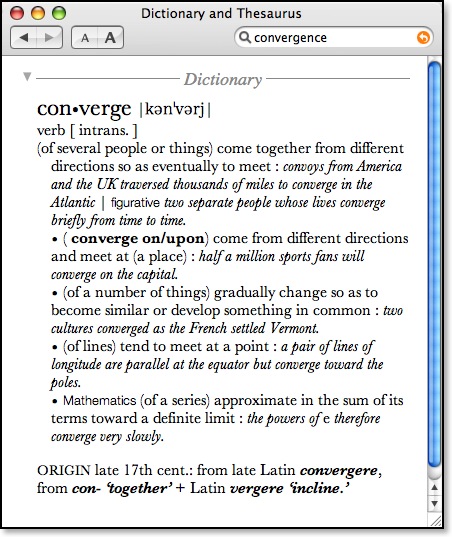
First of all, after a week of use and after experiencing the activation woes I wrote about (see here and here), I can say overall that I'm very pleased with the iPhone. Yes, there are a few features it's lacking, which I'll mention below, but overall, it lives up to its promise. Plus, the key to the iPhone is software and currently it's listed at version 1.0. I fully expect that the rough spots and the gaps in the iPhone's applications will be worked out with software updates in the weeks to come. So while, I'm missing some functionality here or there--some of which I was even used to on my Treo--I'm not really concerned.
In my opinion, when timelines are drawn twenty years from now on the the history of mobile phones and the like, the iPhone will have a prominent place along the line. One could easily point out where another PDA or cell phone does many of the same things the iPhone does, but it's the ease of use and the intuitive interface that's key for the iPhone. Email is easy and works as it should. And internet browsing is not an exercise in frustration as it was on my Treo. On the Treo, invariably, the internet's memory cache would get full and I would have to go in and clear it out. Graphics would take so long to load that I completely turned them off so that I simply had little squares with graphical symbols. Plus, it was invariably difficult to maneuver around a webpage on my Treo because it would convert multiple columns to one column. With the iPhone, a webpage renders correctly (except for Flash, but they're working on that) and you can resize it as you need. Double-tapping on a block of text zooms in wonderfully. The internet is actually usable on this phone, and because the screen's resolution is much higher than a typical computer monitor, even the smallest text is quite readable.
A number of folks have complained about AT&T's Edge data network, specifically in regard to speed. However, when the iPhone sense a wifi internet connection, it immediately switches over to that which is faster than any data network anyway. And maybe Edge is slow to some, but I can tell you it's certainly faster than whatever I was using from Sprint on my Treo 600.
I'm so pleased with the email and internet capabilities of the iPhone that it enables even another level of convergence for me. Often, in making a daytrip somewhere, I'll carry my MacBook simply so that I can check email once or twice while I'm away. The iPhone's capabilities are so extensive, however, that I think I could get by for significant amounts of time simply with it alone. Therefore, on short trips I can now leave my laptop at home and simply carry the iPhone. Traveling light is always a plus.
All the concerns over the iPhone's virtual keyboard are mostly gone by now for those who have spent anytime with it. Mistakes are usually corrected with a tap of the virtual space bar if I'm paying attention and willing to trust the iPhone's own "intuition." I think for heavy editing, I might still like an external keyboard. I admit that I haven't used one of these since I had the foldout keyboard for my Palm IIIe (again, it was just something extra to carry), but such a keyboard would be useful with the iPhone, and it could connect via the iPhone's built-in bluetooth, so I hope third parties are already working on something like this.
One of my early concerns for the iPhone was the relatively small flash drive (8 gb). Only recently have I actually filled up the space on my 20gb iPod purchased back in 2002 (this is a pre-photo, pre-video, old-school monochrome iPod). At that point, I began unchecking a few of the unabridged books I have that take up so much space. But the iPhone encourages a different approach. The idea is not to carry everything with you, but just what you need between syncs. And really, this makes sense. I mean if I listened to everything in my iTunes library, I would have to listen for over three weeks with no sleep. I realize now that it's really unnecessary to carry all that stuff with me. The key is to create albums in iTunes so that you can simply select those and sync over what you think you'll need for the time being.
And that's the other thing about the iPhone. I know folks who have so-called smart phones that never sync them regularly. The iPhone seems to drive the user to sync on a regular basis, to update the content for the next day or two's use.
Having said all that, not everything is rosy. Apple's restrictive policy toward 3rd party apps is a real pain. Two applications I miss from my Palm Treo are Pocket Quicken and Olive Tree's Bible Reader. I kept Pocket Quicken synced regularly with Quicken on my desktop Mac and used the mobile version as a check registry when away from home. And although I usually have access to a Bible with me (or Accordance on my MacBook), there were quite a few times that the Bible Reader on my Treo came in quite handy. On the Treo I carried the Greek NT and the NASB with Greek and Hebrew dictionaries. The only third party apps available for the iPhone have to be created using Web 2.0, so I don't expect anything to reach the sophistication of Pocket Quicken. And so far, I've only come across one Bible program for the iPhone (which I'll review in a separate post), but it's KJV only in addition to Mormon scriptures which are, naturally, of no interest to me. I would really like to see someone create an iPhone interface for something like Bible Gateway.
And there are a few basic missing features on the iPhone. For instance today, Kathy emailed me asking for the address of a family member. I had that information in the contacts on my iPhone, but currently, the device does not allow for selecting text and copy and paste. So while I could look up the information, I couldn't copy and paste it into the iPhone's email program. I still had to retype it. This certainly seems like a step backwards. Didn't the original 1984 Mac have copy and paste?
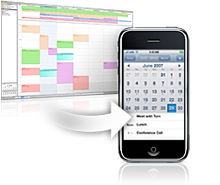
But I'm riding on the assumption that these kinds of issues are minor inconveniences that are inherent to a version 1.0 of the iPhone's software. I'm confident they will be address and hopefully very soon.

However, on a negative note, those "fewest dropped calls" commercials on television are starting to seem a bit disingenuous. Granted my experience is only anecdotal, but I promise you that I've had more dropped calls in the last week with AT&T than I ever did in seven years with Sprint. It's very annoying.
Overall, I highly recommend the iPhone. Yes, the price is a bit steep. But if you can use the features and if it brings convergence to some of the devices you carry, you may agree with me that the iPhone is worth every penny.
iPhone Activation Woes, Part 8 [3 updates]
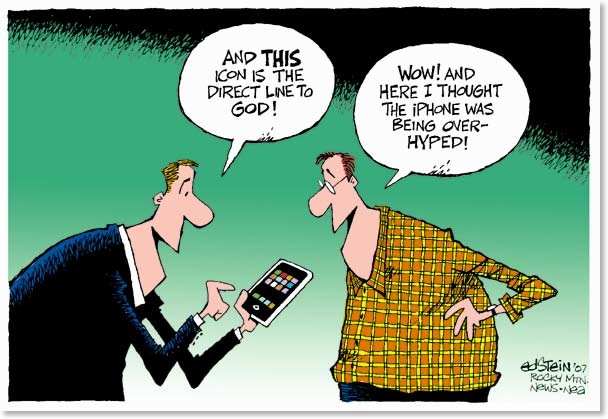
To read my initial tale of iPhone activation purgatory and six subsequent updates, see my previous post.
Quick summary: after waiting 35 hours, AT&T finally activated my iPhone on Sunday. It worked for a little over 12 hours and was deactivated. Kathy's iPhone took much less time initially: only 24 hours. Then, after getting my iPhone reactivated and after about two hours of activation for the second phone, Kathy's phone was also deactivated. So my phone works; hers does not.
Now keep in mind that I first started the activation for Kathy's iPhone on Sunday afternoon. Now it's WEDNESDAY night, and except for the aforementioned two hours, her phone is nothing more than an expensive WiFi capable PDA and iPod. These other functions work because it was activated for a brief while.
I haven't posted anything since Monday afternoon because we've been traveling (we're now actually in Louisiana) and we spent the day with family, but in the last 48 hours or so, the incompetence displayed from the tech support for the iPhone has reached new heights. Now keep in mind, that with the exception of one, all the reps I've talked to have been extremely friendly. And I can't imagine that anyone would have a secret agenda for keeping Kathy's iPhone deactivated. Nevertheless, the events I'm about to relate would be described as a comedy of errors if only it simply were so not funny.
And here's an interesting tidbit: during one of my conversations with a representative from AT&T, he gave me some interesting insights into the problem that go well beyond the late training that AT&T employees didn't receive until the day before the product's release. He told me that the reason I keep getting handed back and forth between AT&T and Apple is that Apple will not release to AT&T complete information about how the phone works. He told me that with the Blackberrys they sell, all support is done entirely through AT&T. Not so with the iPhone.
In the last post, I also mentioned John from Apple who sympathized with my case and promised to stick with me until everything was resolved. To his credit, he has done just that. He lets me use his Apple email address to contact him when successive attempts to activate the phone have not worked after a few hours have passed. And he also never simply transfers me to any other support person. Instead, he's stayed on the phone with me in conference with AT&T. That level of personal support has been graciously appreciated. However, I hate to say it but the biggest blunder in this whole situation also came from his hand.
Over the past two and a half days since my last post, I've been on the phone a half dozen times and have spoken to a dozen or so people. The good thing is that unlike previous days, I don't have to start at ground zero with support. John from Apple has been with me every step of the way. I've been offered all kinds of crazy explanations as to why Kathy's phone is not working. Truthfully, I don't know if I'll ever have the answer, and frankly, I don't really care. Keep in mind that I started the activation on her iPhone on Sunday and now we're at the close of Wednesday and it still is not active.
So yesterday after we had arrived in Louisiana after driving straight through the night, I was going to take a nap when John called me. Believe it or not, I had also handled some of the troubleshooting while driving. John said that he was certain that my SIM card was bad. He knew I wasn't at home, so he asked for the ZIP code where I was. After telling him, he hung up with me, and began hunting down the closest AT&T store. After discovering one about 15 miles away from where I am, he called the store and said he was going to send in a customer to swap out the SIM card.
Now, I'll admit to you, my faithful reader, that upon hearing this, my spidey-sense began tingling. Like anything of this nature, I've investigated these iPhones pretty well, and I was certain I had read that the SIM cards could not be swapped out. Nevertheless, he's the expert right? So I got in the car, picked up an old friend who lives in the area, and we headed to the AT&T store in Bossier City, Louisiana.
At the AT&T store, they switched the card out with no hassle. Of course, I found it odd that they charged me for the new card--a whopping 2¢.
So, I got home, emailed John that the card was switched out, and then we waited. Kathy got another notice in her email that her phone was now activated (between our two phones, we've received about a dozen of these so far). But we waited and then nothing. I emailed John and let him know. He called me back and got AT&T support on the phone. As I've mentioned, everyone has had a different theory as to the problem, but I think this one fellow from AT&T was probably right: he said we should have never switched the SIM card on the phone. Surprise, surprise (I should always listen to my spidey-sense).
I read to him the number of the new SIM card, but his system wouldn't let him change it. He said this was because only certain SIM cards were to be used in the iPhones. He believed that Kathy's iPhone had not activated simply because Sprint had not yet released the phone number. I reminded him that her iPhone did work for about two hours on Monday. Nevertheless, he said that another department would have to help me--one that had the authorization to change the SIM numbers in the system. We toyed with the idea of my going back to the local AT&T store, but decided against it on the assumption that the SIM card was probably discarded in the trash. The fellow from AT&T gave me a case number (FINALLY--a case number! My problem is official!), and said that he was submitting it to a group working on specific problems. He said the wait was longer (meaning probably that since it was the end of the day they were probably gone and wouldn't be back until after the Fourth of July holiday), but that my case was being handled and everything should be resolved within five days. Five days. That's five days from yesterday which means that by SUNDAY, July 8 at the latest, Kathy's iPhone should be active. So we're back to waiting.
So I didn't expect to hear from anyone today. I mean...it's a national holiday, and although I assume AT&T support was open at some level, the guys who tackle the major problems (such as authenticating a rogue SIM card number) were probably eating hot dogs and tossing horse shoes. So last night I settled in for what I hoped was at least eight hours sleep--after only getting about one and a half hours' sleep the previous night because we were traveling and getting only four hours' sleep each of the two nights before that because I was on hold with tech support. I went to bed about 11 PM and set the alarm clock on my iPhone (mine works, you'll remember, and yes, it even has an alarm clock for travel) for 8 AM. That would be a solid nine hours' sleep. And when the alarm on the iPhone went off, I hit the snooze (it has a snooze feature!) In fact, I slept a good extra hour--all the way till nine o'clock. Then my iPhone rang--not the alarm but an actual call.
Because I've talked to so many people at Apple and AT&T over the last four or five days, evidently I'm now on multiple "check back" lists. I've started getting follow-up calls to see if my problem has been resolved. That was the subject of the call at 9 AM this morning. In a very friendly voice she asked if my issues had been resolved. In a very groggy voice, I told her that they had not been resolved, but I had been given a case number and was promised resolution within five days. She told me that they tell everyone five days, but it's usually much shorter than that. I certainly hope so.
At the end of the conversation, she asked what I've come to realize is the obligatory "Have we resolved your problem and is there anything else I can do for you today?" closing sentence. It seemed a bit out of place under the circumstances. I laughed and said, "Well nothing is resolved, but I appreciate your checking on me." That was understandably the only call I received today since it's a holiday.
Stay tuned. Surely tomorrow...
Update 7/5 12:01 PM. Starting over? As expected a representative from AT&T called me this morning to see if my phone was now working. According to her, everything was clear on their end of things. After starting the iPhone over a couple of times, she said, "Well it should work. I can't do anything else for you. Let me get you this number so that you can call Apple."
Then the call dropped. It was another one of these situations that I've experienced where my signal will go from five bars to nothing.
To her credit, she called and left a voice mail giving me the number to call Apple. The problem with this is that now I'm essentially starting over with my problem yet again. So while I called Apple, I also emailed John, the representative who had promised to see my problem through. Meanwhile, a representative from Apple came on and I gave him the twenty second version of what was wrong with the phone: the activation process began on Sunday; it was working for about two hours on Monday, and now it can't get service.
Of course because this fellow is new to me, he begins by going through the same old things I've tried with other reps a dozen times before: turning the phone on and off, switching airport mode on and off, etc. He even at one point asked my area code because he wanted to know if there was coverage where I was. I quickly explained to him that I was using another iPhone to talk to him.
He was about to have me redownload the software for the iPhone and completely start the activation process over when I suggested that we should see if the SIM card number is correct, and I explained to him the issue from two days ago when an Apple rep had me go get a new SIM card. He thought that was a good idea, but of course he has no access to that information on his screen and needed to call AT&T. He put me on hold.
Then the call dropped. Unlike John from a few days ago, and unlike the AT&T rep this morning, he made no attempt to contact me although obviously he has access to contact information. If you've read my entire account of this issue, you'll know that this is not the first time this has happened, and I find it totally irresponsible and the complete opposite of any definition of customer service.
So I've emailed John again, but I got a message back that his case load is extraordinarily heavy today due to being gone yesterday for the 4th, but he'll try to get to me when he can.
Meanwhile I'm just waiting. Considering my problems started on Monday, you'd think my case would have some kind of priority. Actually, I've been told by both Apple and AT&T at different times that it did have priority; nevertheless, I'm simply waiting, and I get the feeling I'm waiting back at the starting line...
Update 7/5 1:54 PM. Attention received, but still waiting. John from Apple has come through once again. He called me stating that he was able to offer some of his lesser account issues to some of his co-workers so that he could concentrate on my issue. Neither he nor I believe there is a problem with the physical phone, but rather in the service on the AT&T side of things. He is running interference for me with AT&T rather than making me do it endlessly waiting on hold and such. Plus he's got much more direct access. I asked him to double-check the SIM card number with AT&T's records. I'm waiting for his call, so hopefully (again) we'll see something resolved very soon.
Update: 7/5 2:46 PM. iPhone working! I'm a bit gunshy to claim the problem is resolved since we've been down that road. However, I am pleased to report that Kathy's iPhone IS now working. John Clark of Apple got hold of a fellow named Samuel Brown at AT&T and together they solved the problem. Exactly what the nature of that problem was, none of us know for sure. Samuel contacted a number of departments at AT&T and there were some flags on the account such as one stating that the number had not yet been ported (it had). It's possible that these flags were in error but simply causing the system to not allow use of the phone. Who knows?
Samuel was nice enough to give me his personal email at AT&T just as John had done at Apple. I hope that we won't have any more problems with our phones, but if we do, at least I now have direct contacts with both companies.
In appreciation for their help, I sent both John and Samuel iTunes gift cards.
So all's well that ends well, I suppose--assuming that it has, in fact, ended.
There's no need for me to write a full review of the iPhone. Those are out there aplenty. But I will give you a few minor thoughts and reflections tomorrow.
Apple's iPhone: GREAT! AT&T's Service: NOT SO GREAT! [6 updates]
The whole ordeal started this past week. In spite of all the hype and mass hysteria surrounding the iPhone, I was undecided as to whether I'd get one until just a few days ago. I do use a so-called "smart phone"--a Treo 600 purchased in 2003 (actually, I've gone through five of them because they're a bit fragile, but fortunately I had insurance with Sprint). After watching Steve Jobs' keynote in which he introduced the iPhone a second time and the slew of videos released by Apple over the last few days, I made my case to Kathy and we decided to take the plunge. I determined that I could cash in some Membership Rewards points from Amex, grab the hundred or so in rolled coins, I've saved for a rainy day, sell the Treo and a couple of other phones I don't use and I should have enough cash to cover the iPhone.
So on Friday, I decided to go to the sole AT&T store in Shelby County, Kentucky, assuming that the crowds would be smaller than at the stores in Louisville. I was right. Kathy and I arrived at 5PM, an hour before the iPhone was supposed to go on sale, and there were only eight or nine people ahead of us. The wait wasn't too bad. Then we bought our phones and left. What's interesting is that with the iPhone, AT&T doesn't activate it for you. It's a process that you do by yourself through iTunes on any Windows machine or Mac.
However, we should have known we were in for problems while still in the store. This was Friday, and the AT&T staff admitted that they had only received training on Thursday. That had to do with the secrecy surrounding the iPhone, and I imagine had a lot more to do with Apple than AT&T. One of the fellows in line ahead of us worked for UPS and described the armed guards that surrounded the thousands of iPhone shipments through the previous night. Procedurally, everything was different to standard AT&T methods in regard to this phone and it showed.
Inside the AT&T store, there were three salespeople, and the store manager who was working in a supervisory role. AT&T corporate had sent a regional manager to work security and determine how many people to let inside at any one time. Nothing in the store seemed to be working right. The system that controlled credit checks (mandatory before the sale) was down. Strict inventory control was in place. Salespersons were only allowed to go get our iPhones after we requested them. The boxes could not be opened while we were in the store, and the bags were sealed before we left. We had to give our name, address, social security number, drivers license number, and email address just to purchase the phone. One of the salespeople kept making errors. I could tell the manager was getting ticked at her, and it didn't help his frustrations when she mentioned she had been an hour late to the training the day before.
We were in no rush, so I took my phone home and waited until about 8:30 to actually attempt to activate it via iTunes. After requesting that my Sprint Treo's number be ported to the new iPhone, filling out the forms, agreeing to the user contracts (one for Apple, one for AT&T), the software ran through this process to activate my phone. It said that it might take up to six minutes. No problem. The instructions noted that once the phone was activated, I might be able to dial out, but initially calls might not come in. Again no problem because all other features of the iPhone should work.
After the six minutes were up, the activation process timed out. I was given a message that further time was necessary for my activation. I quickly received two emails: one from Apple and one from AT&T. One of the messages stated that my activation would take 24 hours and I needed to be sitting in front of my computer on or before 8:35 on Saturday night. Frustrating, to be sure, but I went with it. The interesting thing about the iPhone is that until it's activated, one cannot make use of any of its features, including internet or iPod features. It's essentially a very expensive paperweight unless it's fully activated. Supposedly, there's an option to make an emergency call even if the phone is not activated. When I touched this button (not to actually make an emergency call, but to see where the screen would take me) I discovered that had I been in an actual emergency, the phone still would not have worked because until it's activated, the signal bars remain flat. No one is going to dial out on an unactivated iPhone--not even in an emergency.
On Saturday, about 20 hours into the ordeal, I decided to call one of the iPhone/AT&T support numbers just to make sure all my information was correct when the 24 hour mark should occur. In trying to explain my situation to one gentleman, I was told that my experience was "mistaken." If I got to the end of the iTunes activation screens without some functionality added to my phone, I must have done something wrong. He told me to plug my iPhone back in and start over. Upon doing this, iTunes recognized the phone and gave me the same message about needing additional time to activate my phone. The AT&T representative all but accused me of lying because evidently, this stage of activation limbo was not in any of his documentation. If I didn't see what was in his manual, I must've done something wrong. I told him that his information was not complete and I'm sure he would get a memo on Monday. The call was going nowhere, so I ended it in frustration (although I never got ill-tempered or rude).
So 8:35 came and went and my phone still was not activated. By 11:30, it was now 27 hours into the process so I decided to call AT&T again. This time, a very helpful woman told me that my number had been ported over. I knew this already because my Treo no longer worked and I was having to use Kathy's Motorola phone (we are planning to transition her phone over to AT&T as well but were waiting until mine was finalized first). The representative also informed me that activation for my phone was now complete in their system, but I was in the cue to be activated. She said it should be very soon. In fact, she even very politely offered to call me back in two hours, trying first on my iPhone, but if there was no answer, she would try my wife's phone. Even though I had to get up early for church, I decided to stay up and review my Zephaniah lesson for Sunday. Two hours came and went, and no call, so I decided to go to bed.
This morning at 6 AM, I got up and upon seeing that my iPhone still was not activated, I called AT&T again. Another friendly sounding representative told me that my activation should be very soon--that all my ducks were in a row for activation. She apologized multiple times for the other representative not calling me back, but took down both my number and Kathy's and promised that someone would call to check on us in the next five days. Further, she emphasized the fact that a couple hundred thousand phones had been activated over the last day or two and it had totally bogged down the servers. I'm always polite on the phone, of course, so I didn't say it, but my thoughts were, "And what exactly did you think would happen?!"
Well, again I was stuck in a position of not really being able to do anything, so I tried to just let it go--to push it out of my mind figuring I could always call again after church. Five minutes before 8AM as we were about to walk out the door, I heard the ding of my email, and would you believe that I had a notice from iTunes saying that my phone was now active. I turned it on, and sure enough it was! I knew I didn't have much time since it was time to leave, so I let it sync my contacts and calendar, and I took off for church. The whole activation process had taken 35 hours before I could actually use the phone.
At church, I only specifically showed it to a couple of folks, but it seemed to draw a crowd. I'm really not one to try to show off such things, so I found it a bit uncomfortable to have so many people interested in this new gadget in my possession. After our Bible study class, and what I thought was a very engaging discussion on the book of Zephaniah, I was nearly rushed by four of the men, not to ask further questions about the lesson, but to see the iPhone because they had heard I had one.
I spent the afternoon playing with it, setting preferences and exploring all the features. As for the iPhone itself, I can honestly say that for the most part, it is just as amazing as what you've seen and read. There's no slight of hand when it comes to the commercials. What you see is pretty much what you get. The most frequently heard complaints have been about the virtual keyboard and the slower internet delivery of AT&T's Edge network. By mid afternoon, I was starting to get used to the keyboard. So I don't think this is going to be a big worry at all. The Edge network itself seemed to be out for part of the afternoon, but I happily noticed this morning that the iPhone automatically switched to our church's wi-fi system which made internet access faster than any mobile phone internet delivery system.
My biggest complaint about the iPhone is that text cannot be selected and then cut, copied or pasted. This seems extremely odd because didn't even the original 1984 Mac have this ability? The only bright side to this is that this is a software issue and could be addressed in a future update. In the meantime, I can't imagine doing any heavy text editing on the iPhone without such basic features.
Interesting side-note: after lunch, I went back by the original AT&T store in Shelbville where I purchased the phone because I decided I needed a case (the device is quite smooth and can simply slide out of the hand quite easily). I saw the fellow who sold me my phone and he recognized me. I pulled it out of my pocket and proclaimed, "After 35 hours, it was finally activated!" He immediately stood up and asked if he could see it. I let him play with it for a while. The amazing thing is that even though he had been through the training about the iPhone, he had actually never seen one or held one in his hand before I walked in. He told me that AT&T employees had been forbidden to buy one until demand went down.
So everything looked rosy by the evening. I had gone up to Kathy's school for a bit to help her as she tried to clean up for the end of her year. I noticed that I didn't get any reception in the middle of the building where her library is, but this wasn't surprising. My reception using a phone on the Sprint network had only been sporadic as well that far into her school.
I walked out of her school about 8:30 to see the signal bars rise once again on the phone. I was about to call a buddy of mine when the phone indicated that there was no service. I thought this was very odd for the signal to completely drop out, and it was still not getting a signal when I got home. I came in to check my email, only to notice another iTunes activation message, the exact same wording as I had received this morning. I thought that was really odd. It was not Kathy's activation. It had my number on it. Had this second activation deactivated my phone?! A few minutes later, a second email came in saying the same thing again.
So about 8:50 PM, I called AT&T on Kathy's Sprint phone which we have left active until my phone is straightened out. I was on hold 42 minutes when suddenly and without warning I got disconnected. So I called a second time. After 46 minutes I seemed to have left the queue because the line started ringing. But no one ever picked up. Then suddenly, I was disconnected again.
So I called a third time, and I'm still waiting. Kathy's phone notes that it's been two hours and seven minutes since I first made this call. I've been on hold the entire time. Two things to consider: each time I've called tonight, the AT&T recording says that due to extremely high volume the average wait time is only 20 minutes. Ha--if only I could be so lucky.
Also, it should be noted that AT&T has only ONE hold song--some piano tune that could surely be used to torture captured enemy combatants.
So now, after being on hold for two hours and ten minutes, someone finally picked up on the line. She said my phone is no longer showing an activated status, but a pending status because I have an incorrect service plan. I told her that the service plan I chose, I chose from within iTunes--a family plan for 1400 shared minutes. She said she couldn't help me, but would have to transfer me over to customer care. I asked her what was wrong with my plan, and she said she couldn't look it up because their system was down.
So, now it's 12:44. AM I've been on the phone for four hours trying to get my iPhone activated again.
The wait for customer care was not as long. Evidently I got sent straight in. The customer care representative told me that there was nothing wrong with my plan. So she's sending me to another department. But she warned me ahead of time that this wait might be quite long.
Also, interesting tidbit. According to this person I just talked to, she said sales of the iPhone have been stopped until all current customers are activated and stabilized.
Again, I have to ask, What did they think would happen?
It's 1:00 AM. Still on hold. I'm going to post this and I'll update more later.
Update 1:53 AM. I finally got through to this third department. A very perky rep said that she sent my activation through, but I still never got any signal bars. I asked if she knew why my phone was deactivated to begin with. She said she didn't know because the system was down.
While I had her on the phone, I asked her to check on the status of my wife's phone. She said that there was a problem with the wrong sim card in the phone. I pulled it out and read her the number to which she said, "No, that's the right one."
But ultimately, with their system down, there was nothing more she could do for me tonight. She suggested I call back in six or seven hours. I only wish I could get that much sleep, but I have to be somewhere in the morning at 6:30 AM.
Right now, when I try to call my cell phone number from my wife's phone, I don't get the new voice mail message I set up earlier today. All I get is a message saying that the number is not valid. I hope to goodness that somehow in all this AT&T hasn't lost my number.
Okay, I'm going to bed. More later.
Update 8:53 AM: RESOLVED. I had an early meeting this morning, and afterwards came back home intending to take a nap after having only four hours sleep last night. Instead, obsession got the best of me, and even though the six or seven hours I was told to wait before calling back had not yet passed, I called anyway.
But here's the intriguing aspect. When I went to make my call, Kathy's Sprint phone would no longer work, thus indicating her phone number had been transferred to AT&T. I checked her email, and sure enough, there was a message stating that her new phone was active. So using her iPhone, I called AT&T again, and upon reaching a second level representative, I found someone who could really help me.
She told me that there were definitely some problems with my line, but they didn't believe it had anything to do with the actual phone based on what I was telling them. The AT&T rep was extremely friendly, and I made sure I remained friendly as well (Mom always taught me to be polite on the phone). She put me on hold a number of times while she checked with engineers on this or that. At the very least, in contrast to five hours of rabbit chasing last night, I felt like I was finally getting some attention to my problem.
They were about to pursue one possible solution to my problem (I had already been told that my case seemed to be unique), when on a hunch, she had me read to her the SIM number from my phone. She immediately recognized the problem. In some weird series of events, the registration of Kathy's phone had copied her SIM number over to my records and thus my problems began. I asked her if there was anything I did incorrectly. I explained that I used separate login accounts on our computer for each phone as well as separate iTunes accounts. She said that I did everything correctly, but her guess is that the error occurred because of the high volume of activations over the weekend.
After making the corrections to my settings on her end, the iPhone started working almost immediately.
Again, this AT&T rep was very friendly as have been all their employees that I've talked to (with the exception of the person who argued with me over what I was telling him my screen said). But the title of this post stands because I simply don't think AT&T was adequately prepared for this level of new activations--and they should have been since none of this was a sudden surprise, and they had months to get everything in place.
I believe the idea of activating one's own service is a great one, but this was not the product launch to test it out. The internet is filled this morning with horror stories similar to mine, and in the discussion forums on Apple's website (as of this writing) nine out of ten comment threads are negative in nature. It will all blow over as problems like mine get resolved, and the iPhone itself is an exceptional and perhaps even groundbreaking product. But for me as a new AT&T customer, I've begun my TWO YEAR contract with a really bad taste in my mouth.
Update 10:13 AM: NOT Resolved After All: Okay, so ten minutes after getting off the phone with tech support, Kathy's phone stopped receiving a signal. Same song second verse. I called the same number back, got put through to a number of different departments. After going through my problem, one fellow told me that he couldn't help me, but I needed to call a number that he needed me to write down. I wrote it do it down and hung up only to realize he had just given me the original number I had called to begin with. Maybe we could give that a new name: "Circular Support."
So, now I'm back on hold again. This time, AT&T is transferring me over to Apple.
Update 11:30 AM: Still on hold. I've talked with half a dozen folks in the last hour or so. I keep getting transferred. I wish I could get the same woman again who got my first phone working this morning. Recently, AT&T transferred me to Apple. He wanted me to do inane things like walk outside with the phone to see if I would get better reception--in spite of the fact that I was talking to him on the AT&T network on the other phone from the inside just fine, and in spite of the fact that I was using the phone inside this morning before it died. He wanted to know where I live to see if I had coverage--AGAIN, in spite of the fact that I was on an AT&T phone with him. And would I switch to a company without checking to see if I had coverage first?
After exhausting all these kinds of options, he asked me to hold so that he could get an AT&T person on the line. After I talked with this person for a few minutes, he told the Apple guy just to switch me over to him completely because he said he knew what the problem was.
And so I remain on hold while he's checking on something, eating a donut, smoking a cigarette or something...
Update: 12:55 PM: Starting all over again... After getting two hours into the most recent round (of being switched back and forth between Apple and AT&T), the call dropped. Now it's obvious that the person to whose level I had finally climbed had my phone number because this is inherent to the problem. However, in a move that's an obvious affront to the very nature of customer service, she chose not to call me back.
So I've had to start over yet again. Kathy's phone still won't work even though it worked earlier today. It simply says there's "No Service" even though the other phone is picking up service just fine. I'm about a half hour into the climb to find someone who hopefully will be able to help me. Of course, I was two hours into it last time, which also was essentially starting over as well since they had me call the same number I started with.
Update: 2:37 PM: Waiting. After climbing the tier of response for an hour I was transferred again from AT&T to Apple. I told my story to an Apple rep named John Clark, who was sympathetic to my situation. He told me he was taking ownership of my problem and one way or another he would see it through. Right as I was about to give him my phone number in case we got disconnected, the call dropped! However, true to his word, he emailed me asking for my phone number. John called me back and we started working our way through potential issues that could be causing his problem. He did have to consult AT&T at one point, but he did not transfer me back to them, but put us in a conference call. They seem to think that multiple activation commands have been sent in on some of these phones that upon receiving subsequent commands, have negated the original one. Currently, Kathy's phone is in the queue for activation again, so now we just wait. But John gave me his direct email address and wants me to check in if the phone activates or check in every two to four hours if it doesn't. So that's where we are. I guess I'll go get a shower and start my day...
Mac OS X 10.5 (Leopard) Minimum Requirements

- an Intel processor or a PowerPC G4 or G5 processor
- a DVD drive
- built-in FireWire
- at least 256 MB of RAM for a PowerPC based Mac, and 512 MB for an Intel-based Mac
- a built-in display or a display connected to an Apple-supplied video card supported by your computer [The Installer may not support your video card.]
- at least 6 GB of disk space available, or 8 GB if you install the developer tools
Presumably the final minimum requirements would not be that different. However, it's notable that PowerPC G3 processors were included in Tiger's specs, but not in Leopard's. So if these remain as the final minimum requirements, it would mean the first release of OS X that won't run on G3 Macs.
The Great Apple Blunder of 2007
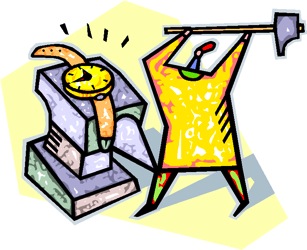
Today, while I'm sure that there are a few exceptions here and there, I would guess that most folks like me who use a Mac do so by choice. That's true for a lot of Windows users, too, but for many it's not true. I would guess that for many Windows users, if given good compelling reasons to switch, and given the ability and opportunity to do so, they might just make the move.
That brings us to the current situation here in 2007. This year saw the release of a new Windows OS, Vista, and the promise of a new Mac OS, Leopard (OS X 10.5). Originally, Steve Jobs promised that Leopard would ship pretty much at the same time as Vista. That didn't happen, but we were told that Leopard would ship before the end of the Spring (which if held true would have probably been pretty close to the beginning of summer).
Then on April 12, Apple made a surprise announcement: Leopard will be delayed until October so that Apple's engineers can concentrate on bringing the iPhone to market. I'd simply link to the announcement, but there's no separate page for it. It's in the list on Apple's "Hot News" page and presumably will eventually scroll off once other news items are added. But here it is in its entirety. If you've already read it, simply move on to the next paragraph.
iPhone has already passed several of its required certification tests and is on schedule to ship in late June as planned. We can’t wait until customers get their hands (and fingers) on it and experience what a revolutionary and magical product it is. However, iPhone contains the most sophisticated software ever shipped on a mobile device, and finishing it on time has not come without a price — we had to borrow some key software engineering and QA resources from our Mac OS X team, and as a result we will not be able to release Leopard at our Worldwide Developers Conference in early June as planned. While Leopard's features will be complete by then, we cannot deliver the quality release that we and our customers expect from us. We now plan to show our developers a near final version of Leopard at the conference, give them a beta copy to take home so they can do their final testing, and ship Leopard in October. We think it will be well worth the wait. Life often presents tradeoffs, and in this case we're sure we've made the right ones.
Apple has been making computers for 31 years, this month. But due to the success of the iPod, iTunes, and the release of AppleTV and the upcoming iPhone, Apple Computer made the decision earlier this year to change its name to Apple, Inc. to reflect its diversity of product offering. In my opinion, the above announcement regarding the delay of Leopard says clearly that this is a company stretched way too thin. Computers are what made the company. No Mac user such as myself should begrudge these other products because in many respects, they've added to Apple's bottom line and in that regard have supported the ongoing development of Mac hardware and software. Yet, going all the way back to the mid-eighties and the context of that infamous Gates' memo, the Mac OS has been the underdog--the underdog that could've been the top dog.
Two days ago I had lunch with the owner of a computer/network consulting company for which I used to work a few years back. 99.99% of his company's work relates to Windows networks and workstations. Occasionally if he has a Mac issue, he sometimes will still call me, but that hasn't happened in a while. In the midst of our conversation, he made the statement, "By the way, I hate Vista." I was really taken aback by this. I've got a copy of Vista installed on my MacBook in Parallels. To be honest, I kinda like Vista, perhaps if nothing else because the interface somehow feels more Mac-like to me than previous versions of Windows. But then again, I only have a couple of Windows programs that I occasionally run, and I don't run these everyday. Vista is not mission critical for my work. I don't use Vista all day long. But he went on to describe clients of his who've had nothing but trouble with Vista.
And he's not alone. Certain federal agencies have placed a ban on upgrading computers to Vista. Earlier this week, a northwest CIO made headlines because he is contemplating moving his organization from Windows to Macs. Yesterday, I read that Dell Computers "will restore the option to use Windows XP on some of its home systems, marking a potentially damaging blow to Microsoft's hopes for the newer Windows Vista." Many of the individual complaints I've heard about Vista have to do with this or that scanner or assorted peripheral not working with Vista due to lack of drivers. People have short memories because I remember hearing similar complaints about Windows XP in 2001, but eventually solutions were found for most problems. Nevertheless, while people have always complained about Windows in one form or another, I don't remember ever seeing this much discontent and this much balking to the idea of upgrading to a new Windows OS.
And that brings me back to the old "strike while the iron is hot" idea. It's already too late to take advantage of it, but Apple was handed a prime opportunity to take advantage of Vista's shaky reception by pushing the Mac as a more suitable upgrade. Granted, the current Mac OS (Tiger) is extremely stable and can hold its own against Windows, but what a missed opportunity on Apple's part not to offer their new OS, Leopard, at the same time as Vista!
But this is the new Apple, Inc., not Apple Computer. And I believe that what a lot of Mac users feared when the name change was announced is coming true--the computer division of Apple is taking a back seat to its other product offerings. In spite of their growth, Apple's announcement to delay Leopard not only proves that they don't have the resources to steer two new technologies simultaneously, but also that the older product takes a backseat to the newer.
Of course, Apple is betting on the iPhone becoming a huge success. And maybe it will. But who knows? And I'm sure there's a rush to get the iPhone to the market before the copycats bring forth their phones. Personally, I'd love to have one, but not at that price tag. Plus, we all know that the first generation iPhone will not be the one to get. Let the early adopters suffer through the first incarnation and then the rest of us who want to can get one when the second or third generation is released (in the meantime, I haven't renewed my Sprint contract).
Nevertheless, Apple missed a great opportunity by delaying Leopard and putting all of it's resources on a market it has no history in. And they did it on the risk of an unproven product. Hopefully it will work out for the best, but by the time Leopard is finally released, Vista's kinks may well be worked out, and the iron will no longer be hot.
Waxing Nostalgic for Old Apple Hardware: The Irony of the iPhone
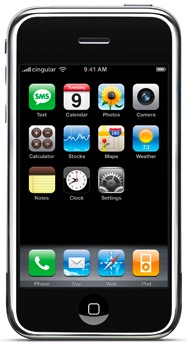
But it's ironic not just because Jobs would introduce yet another peripheral, but instead the irony lies in the kind of peripheral introduced. The new iPhone incorporates not just an iPod (really just an iPod nano) and a phone, but also a device that will contain calendar, contacts, and email much like the Apple Newton canned a decade ago by Jobs (although Newton holdouts are claiming that spec for spec the Newton does more). The iPhone also incorporates a 2 megapixel camera, even though one of the products killed by Jobs when he did away with the Newton was Apple's Quicktake Camera.
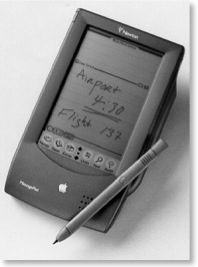
I have to admit that it's tempting to purchase a refurbished Newton from J & K, but it's hard to justify the $150 price on something that might end up becoming simply a collectable novelty than something of practical use. I carry my laptop with me everywhere as it is and sometimes wonder if I even need the PDA functions of my Treo.
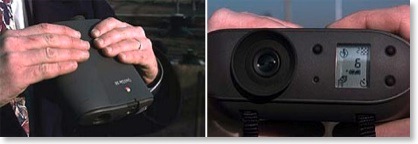
Or maybe I haven't found them yet. Are there any secret Quicktake photographers still out there?
One More Thing About the Keynote...
AppleTV, iPhone, But Nothing Macintosh: Makes You Wonder if Macworld will be Changed to Appleworld?
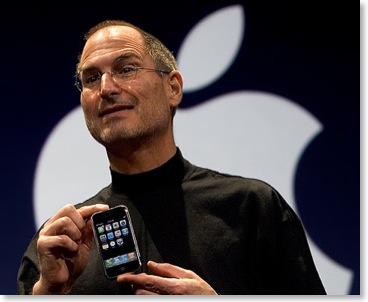
I, for one, have mixed feelings over the name change. As the keynote was going on yesterday, I was checking in online on some of the news sites to keep up since the streaming video wasn't released until much later. After wrapping up the iPhone presentation, I thought to myself, "Is that it? And if this is Macworld, why isn't there any reference to the MACINTOSH?!" And it looks like I'm not the only one who thought this was weird (see Paul Therrott's "About the Mac-less MacWorld [sic] Keynote" and Rob Griffith's "Expo Reaction: iDisappointed").
Don't get me wrong, I think the iPhone really is revolutionary (to use the word everyone else is describing it with). I would gladly trade my Treo for one and even jump from Sprint to Cingular (however, like a lot of folks, the high price [$499-599] is going to keep me away from the iPhone party). Nevertheless, my main interest in Apple is related to the Macintosh. As the iPod has risen in popularity, a lot of us Mac users have been a bit uncomfortable that the Mac has been a bit neglected in recent years. The recent Mac vs. PC ads have dissuaded some of this anxiety, but then yesterday Steve gives a keynote at MACWORLD and doesn't talk about MACS?!
The iPhone seems to be an amazing product. If you haven't watched the presentation of it via Quicktime, do so now. Apple is promoting it as combining the features of an iPod, mobile phone, and internet connectivity device. As for the phone features, they are saying it reinvents the phone. With 200 patents on this device, maybe so; and while I'd be glad to trade up from my Treo, this is far from being a perfect solution. The first detraction in my opinion is the small amount of memory for an iPod. This device comes in either four or eight gigabyte models because it is using flash memory. This isn't an iPod replacement--it's an iPod Nano replacement! I imagine that people will get very frustrated once they realize they have to be highly selective in choosing the music, video and pictures they carry on the device. And wait until software development begins, which is bound to happen since the device is running OS X. 4GB or 8GB is not going to be enough room to make people happy. Granted, the iPhone would have to be much thicker, but if Apple makes all these multimedia promises, then give us a 60GB drive in the thing for the love of Margaret!
Another problem with the iPhone is going to be its low 5 hour battery life for continuous use. Although I've got a Treo for which I access email, text messaging and the occasional email, I've never been inclined to play games or watch video because it runs down the battery. On normal use my Treo is good for a couple of days between recharges. But the iPhone is meant to be a media device in addition to being a mobile phone. Further, it's not going to be as with some devices that you can simply carry an extra battery--you won't be able to swap out batteries on the iPhone just like you can't on an iPod. Heavy users better be ready to simply carry a power supply with them.
And while that new "multi-touch" screen looks pretty nifty, it will drive those who abhor fingerprints downright crazy. The advantage of a stylus or mini-keyboard on most smart phones is that fingerprints are minimized.
Finally, the cost is going to be a major problem. This shouldn't be surprising because throughout Apple's history, they have not just made superior products, they have charged premium prices for them as well. While I'd love an iPhone, I already know it's out of my price range. The initial market for the phone is obviously aimed folks like me who use smart phones already. But that market is only so big. For this to really be successful, Apple has to aim for the iPod crowd, which is in the tens of millions. But how many will pay $599 for a phone when they can get a lesser-featured phone for free when they sign up for a new plan? I have no idea how much it costs to make the iPhone, but if they really want to take the world by storm with them, a $299 price would be much more reasonable. Maybe by the second or third generation, the iPhone will come down in cost and I will consider getting one.
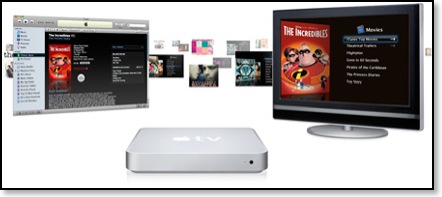
Back to the keynote... As a Mac user, I always look forward to the keynotes. There were a number of things related to the Mac that I was looking forward to hearing about that simply weren't addressed. This was surprising because had it not been for the AppleTV and the iPhone, they certainly would have been the main features of the keynote.
For instance...
Where was the demonstration of a mature, soon-to-be-shipped, Mac OS X.5 (Leopard)? Back during the summer Jobs told us that he was not revealing everything about Leopard yet because he didn't want Microsoft to copy everything in Vista. Well, Vista is out, so a lot of us were expecting a full demo of the new OS X.
Where was a preview of new features in iLife '07? Besides iMovie, iDVD, GarageBand (the last of which I have no use for), I was especially looking forward to seeing a newly retooled iWeb. I've said that if it addresses my complaints of the v. 1 shortcomings, I may very well convert this site over to iWeb.
Where was a preview of new features in iWork '07? iWork was slighted as it was in last year's keynote, in spite of the fact that it's a rapidly improving productivity suite from Apple. With last year's release, I completely abandoned any use of PowerPoint in the classroom in favor of iWork's Keynote which offers much more of a professional look in my opinion. Although I don't use Pages a whole lot, I've been using it more over the past year. Plus, the rumor is that a spreadsheet app will be added to the mix this year making iWork an actual competitor to Microsoft Office.
Speaking of which, where were demonstrations from third party Mac software developers such as Microsoft and Adobe? I would have guessed that someone from Adobe would have taken the stage to demo the next version of Photoshop which will feature a universal binary for much faster performance on Intel Macs. Also, I would have expected Roz Ho, general manager for Microsoft's Macintosh Business Unit to take the stage to promote the upcoming Mac Office 12, now re-christened Mac Office 2008 (even though it will be released in 2007).
I don't use all the apps in Office as much as I used to, but I do still use them, and would have liked to have seen such a demonstration which has been fairly standard in the past at these events. Instead, Microsoft was left to simply releasing its own press release and its own interview with Roz Ho. The main selling points of the new version of Office seem to be it's Open XML file format as well as new interface. Interestingly, from the pictures I've seen the new interface seems to borrow less from Office 2007 for Windows and more from Apple's own iWork suite.
Also, I might've expected someone from Intel to talk about upcoming processors, leading Steve to talk about the Mac's future road to technology. But nothing...nothing about Macs was said at all. It was all AppleTV and iPhone (and 3/4 were simply about the iPhone).
Maybe my misgivings about everything non-Macintosh from Apple is counter-productive. Certainly the success of the iPod has kept Apple a strong company and this feeds into Apple's ability to produce high-quality computers such as the MacBook I'm typing this on. And I suppose that Apple has to think about the future and diversity means greater security.
But wasn't there also a time when Apple produced computers, printers, cameras, scanners, a PDA (the Newton), and Jobs axed all the peripheral to get back to the roots of the company--the actual Macintosh computer. Am I the only one who remembers this? Maybe the difference is that products like the Apple Quicktake Camera weren't near as successful as the iPod and therefore put a drain on Apple's business. But I wonder if in five years or so we won't see another wave of product streamlining. I just hope that when it comes to it, it won't be the Mac that's lost in the shuffle.
iWeb Revisited

Currently I use RapidWeaver, which overall I like, but I wish I could combine the best of RapidWeaver and the best of iWeb into one program. For instance, the creators of RapidWeaver have been promising a table generator for RW for the longest time, but it's never happened. Currently, if I want to create a table, I have to create it in DreamWeaver and paste the html code into RW. However, because iWeb uses the same objects created in Pages or Keynote, I could create a better-looking table in one of those apps and paste the object itself into iWeb.
Although I like iWeb--or at least the promise its features seem to give--my complaints against it are significant. I update my blog more than any part of my website, and at iWeb's release there was no ability to natively add comments or trackbacks. There's still no trackbacks, but in an interim release earlier this year, comments were added and I actually like their implementation better than the Haloscan comments I use on this site. Another big problem I had with iWeb was that it didn't allow for html snippits. So there's no way to add sitemeter, a blogrolling.com list, a YouTube video or even any of the occasional Amazon Associate ads that I place on here. Actually, there are a few third-party utilities that help with this, but they are all hacks in one way or another. And generally I don't like to add hacks to software or my OS because invariably if the original company updates the software, the hack is incompatible and causes problems.
iWeb also doesn't allow the creator to change templates which I find to be mind boggling. Even Blogger allows for a different template for any whim of a reason. The templates that come with iWeb are very creative, but none are exactly what I want. Of course, I haven't found a perfect template here in RapidWeaver, either. The current one I am using is a compromise.
However, with the coming year, hope springs eternal that iWeb will be updated to addresxxxxxxxxxxxs some of its shortcomings. iWeb isn't popular enough to get a lot of attention in the rumor mills, but Think Secret posted some info a few weeks back that seems to indicate that iWeb 2.0 will add a lot of the features that should be there already. If everything that has been rumored is true, I may very well switch to using iWeb instead of RapidWeaver for my site. That doesn't mean that I would every take down these pages because some of my posts have various links to them from elsewhere. But I would gradually recreate as much as I could of the blog and completely move over the other pages to iWeb.
In the meantime, I'm going to create a very scaled down "This Lamp iWeb Mirror Page" as a kind of experiment and so that I can become more familiar with the program. For every post I add here, I will also create a copy there and perhaps a couple of previous posts as well. My hope is that iWeb 2.0 will allow me to change templates because I really don't like the one I'm using in iWeb, but it will work best with my blog. If iWeb 2.0 doesn't serve my needs and I don't switch, I won't have put too much effort into my little experiment.
Link: This Lamp iWeb Blog Mirror
What He Said
“When you get past the schoolyard mentality and the stupid, ignorant prejudices,” you have heard people say, “what we have are two different operating systems that each work very, very well. Really, it’s not a matter of good or bad. It’s just a matter of personal preference.”
Those are very wise words. I have said much the same thing. But what I’ve endured over the past few months is the equivalent of a weeklong road trip with someone whose company you’ve always enjoyed, but never really known as a true friend. Windows has propped its bare smelly feet up on my dashboard and told me the story about how he was so hung over during his aunt’s funeral that he threw up into the coffin a little. His greasy hair has left smears on the inside of the window that no solvent can shift. He just sort of assumed that he could use my iPod, and during the one time he took a turn at the wheel, the battery was completely flat and I had to listen the story about the funeral a second time.
I made the switch from Windows to the Mac in 1998, and I've never looked back. In fact, I only wish I had been smart enough to do it sooner. That year--1998--I was serving as an associate pastor at a church where I was put in charge of creating worship slides in PowerPoint as we experimented with this whole new idea of using our projector instead of printed music for worship. I was attempting to use PowerPoint '97 in a fresh install of Windows '98 on a brand new Compaq computer that I had just purchased with my own money.
And it kept crashing.
And crashing.
And crashing.
And crashing.
I wasn't using any kind of fancy graphics--nothing extravagant at all--just the words for the songs. I was saving my file constantly because every two or three slides and the whole computer would freeze, filling the room with the blue glow of the Windows "screen of death." If you've ever used Windows for any period of time, you know this frustration. Yes, you do; don't deny it.
And I had set this computer up myself. Like Andy says in his article, I, too, was no slouch around Windows myself. Heck, I'd been using computers since I was 14 in 1982, starting with a TRS-80. I learned the ins and outs of MS-DOS, and I began using Windows at the 3.0 release (not the 3.1 update like everyone else). I had migrated up through Windows '95 and then finally Windows '98. And as that Compaq kept crashing, I thought to myself that there had to be a better way.
Like lots of hardcore PC users, I was very anti-Mac; and I looked upon the Mac crowd as a bunch of idiots who didn't really know how to use a computer. But as I looked at my alternatives, I realized that I should give this Mac thing a shot. So, in 1998, I ordered my first Mac--a 300 mhz "Wallstreet II" PowerBook with a 14" screen.
As I began to use the Mac, I was delighted to discover that although it could crash, too, it didn't do it near as much. The Mac was much more stable than any Windows machine I had ever used. And ironically, Microsoft PowerPoint for the Mac WAS MORE STABLE than Microsoft PowerPoint for Microsoft Windows. Go figure.
If you're a diehard Windows user, you may want to write me off as a Machead blowing smoke--just like I used to do. But I tell you that when it comes down to the bottom line of user experience--all things considered--the Mac simply works. Yes, OS X can crash, but I can't remember the last time it did. Can you, if you're a Windows user, remember the last time your XP machine locked up? Probably. Yes, sometimes there are problems with Macs such as the recent Macbook Random Shutdown fiasco, but often computer manufacturers often have initial problems with a new product. My experience with Apple over the past eight years was strong enough that I bought a new MacBook myself recently.
Unfortunately, I've had to keep a foot in the Windows world all these years since I switched. From 1999 to 2000 I worked part time as a computer network specialist for a consulting company in which 99% of our work was related to Windows machines. And when I taught high school, I also spent three of those years as administrator of the school network (three Windows servers and 140+ Windows clients). Plus, even since switching to the Mac, I've kept a copy of Windows loaded: first in VirtualPC, and now in Parallels Desktop. So I still use Windows now and then; I've been able to keep up.
But I still don't like Windows. All the time I spent working for the consulting company, and all the hours put in on the school network and fixing this or that problem with various Windows PCs always made me appreciate my Mac experience all the more. Even now when I have to use Windows for whatever reason, I just come away feeling a bit...well...a bit dirty.
And don't read me as as one of these anti-Microsoft Mac folks. I'm not anti-Microsoft. I have Microsoft software on my MacBook. Some of Microsoft's ideas are innovative and some of its technologies are robust. I've read two of Bill G's books, and I think he would be an interesting person to sit down and have a conversation with. But I think the whole Windows thing is a scam, and in the end I believe it was a bad idea to let MS Windows become the dominant OS platform. The Mac is not perfect either, and I don't agree with everything Apple/Steve Jobs does, but I'll take OS X over Windows any day because it just works. That's the bottom line of it all. I can sit down, use my computer to do what it's supposed to do, without it crashing, without worrying about viruses or spyware, without my system getting slower and slower as the weeks go by.
So when I read Ihnatko's article, I just had to say..."Yeah, WHAT HE SAID!"
The New Look of Leopard Previewed in iTunes 7?
The OS X Aqua interface has had a translucent candy-like appearance since version 1.0. Way back when Steve Jobs first showed it off, he said the interface looked so good, you would want to lick it. Well, I've never been into an OS that much, but Aqua did look good back in the day. Basically, it was a reproduction of the translucency in the original iMacs that had helped Apple regain a place of significance in the computer market. But gradually, the candy-colored look of Aqua has started to get old after five years. It has been lessened over time--the pinstripes, for instance, have been toned down or removed altogether from many applications.
So, after installing iTunes 7 and exploring all the new features, something else jumped out at me. Other than the standard red, yellow and green buttons in the top left corner, there's no translucency in the iTunes 7 interface at all. Compare versions beginning with the previous version 6:
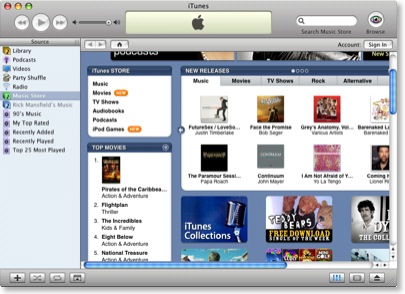
The most obvious example of translucency in the above image are the scrollbars, but the sign-in, play, forward, reverse, and home buttons are all translucent.
Now notice iTunes 7:

As I mentioned earlier, the only translucence in the interface is found in the buttons in the top left corner. None of the other buttons have a glassy translucence at all. Now if that were the only change, I might not have thought anything about it. But notice the scrollbars. The trademark translucent blue is gone, replaced by a shaded slate blue.
Now this is very interesting. Last month at the Worldwide Developers Conference, Steve Jobs remained oddly tightlipped about the upcoming version of OS X, codenamed "Leopard." He did show off ten new features, but said that he was keeping much of the new OS to himself for the time being so that Microsoft couldn't copy everything into the upcoming Windows Vista. At the time, this sounded simply like another jab at Microsoft from Jobs, but what if there really is something to it?
Consider this. It's no secret that Microsoft has always seemingly taken its cues from Apple in regard to its Windows interface. And in the new Windows Vista, translucency is everywhere. But it's not called "Aqua," of course--that would be too obvious. In Vista, the interface is called "Aero" (I'm not kidding). Here is a screen capture from Microsoft's own website:
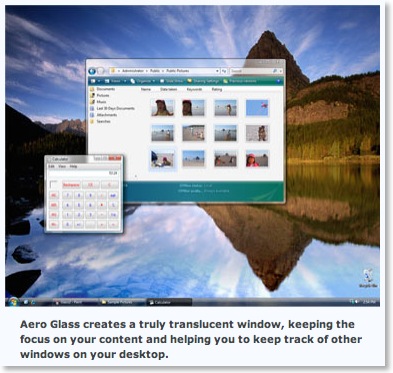
You can't blame Steve for wanting to keep some of the features in the next version of OS X secret until Vista ships. And wouldn't it be funny once Vista is released in all of its Aero translucency, if Steve simply declares the see-through look passé and removes it entirely in the final release of Leopard?
For Microsoft, that'd be like showing up to the dance in last year's dress.
Wouldn't that be a kicker?
Apparently, I'm not the only one noticing this. See "Aqua Is Dead, Long Live Aqua" at the Unofficial Apple Weblog.
So Dark the Con of MAC (The Apple Computer - Da Vinci Code Connection)
Apple's New Slogan
"What's an Intel chip doing in a Mac? A whole lot more than it's ever done in a PC!"
The 2006 MacWorld Keynote: Viewing Between the Frames
I wasn't one of the fortunate ones able to sit in San Francisco to see and hear Steve live. I was one of the losers going back and forth between MacCentral and MacNN, constantly refreshing my screen for the updates. The video is now released in streaming Quicktime format, but too many people are hitting it and it's an exercise in frustration right now. Therefore, I'll write a few initial thoughts about today's revelations.
There was a lot of new information that Steve gave us, but as I read the updates, I felt like there was a lot we weren't hearing. This blog entry serves to "view between the frames" by giving you my speculation and hunches about some of what really was going on. I'm not trying to give an exhaustive examination of everything covered in the keynotes. There will be quite a few other sites doing that today. Here are just three three or so items that jumped out at me. If you agree or disagree, you're welcome to speculate with me in the comments below.
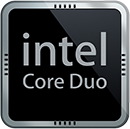
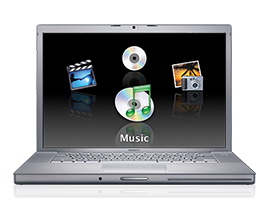
Second, anyone notice that the old comparisons between PowerPC processors and Intel processors are now officially a thing of the past. I mean the initial switch announcement surprised us anyway after we were told so many years that Macs with their PowerPC's were supposed to be so superior to Intel processors. And all those speed tests that made it look like Apple produced the fastest computers in the world! Now we're being told that the new iMacs are two to three times faster and the MacBook Pros are FOUR TIMES FASTER than the latest PowerBook revs. And if you go to Apple's site and look at the specs, these aren't even the fastest processors that Intel makes. Of course, the truth of it is that most currently manufactured processors are fast enough for the average application provided you have enough RAM and you aren't being slowed down by spyware and the Windows virus of the week. I'll be very interested to see what kind of specs are on whatever they call the replacements for the PowerMacs later this year. But now that the playing field has been leveled processor-wise between Apple and it's Windows cousins, processor speed comparisons will strictly be a thing of the past. But don't all of us Apple faithful feel like chumps now for believing what must've been a speed myth now that the new Macs are TWO TO THREE TIMES FASTER!
Third, is it just me, or does "MacBook Pro" seem like a clunky name? Is this just a bad take-off of the old WinBooks which was a take-off of PowerBook to begin with? How ironic. And will the iBook replacement merely be "MacBook" without the "Pro"? Like a friend of mine said, you'd think that with all of Apple's million dollar marketing geniuses, they could've come up with a better name than MacBook Pro.

What are your thoughts? Am I too suspicious or do you think there were a few corporate conspiracies in place, even if they were created just for the hype. Feel free to share your questions, thoughts, comments, and rebuttals.










